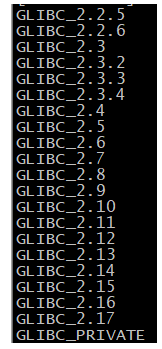1. 消息中间件概述
1.1. 什么是消息中间件
MQ全称为Message Queue,消息队列是应用程序和应用程序之间的通信方法。多用于分布式系统之间进行通讯。
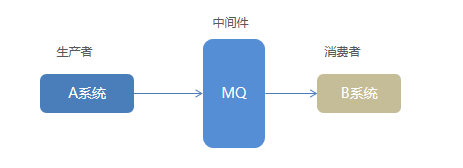
优缺点
优点:引用解耦、异步提速、削峰填谷
缺点:系统可用性降低、系统复杂度提高、一致性问题
优点
为什么使用MQ
在项目中,可将一些无需即时返回且耗时的操作提取出来,进行异步处理,而这种异步处理的方式大大的节省了服务器的请求响应时间,从而提高了系统的吞吐量。
开发中消息队列通常有如下应用场景:
1、异步提速:任务异步处理
将不需要同步处理的并且耗时长的操作由消息队列通知消息接收方进行异步处理。提高了应用程序的响应时间。
之前:订单系统先去访问DB,然后去访问库存系统、然后访问支付系统、然后访问物流系统,整个过程花费的时间很长。
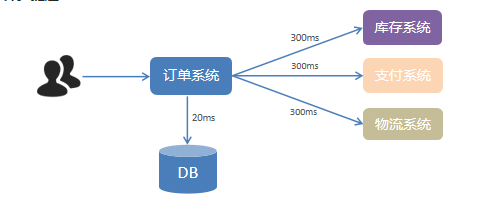
引入MQ之后:用户先访问DB,然后发送请求给MQ,MQ再发送请求给各个系统,之后返回响应,系统各自的服务自己异步执行。让用户可以更快地得到反馈。
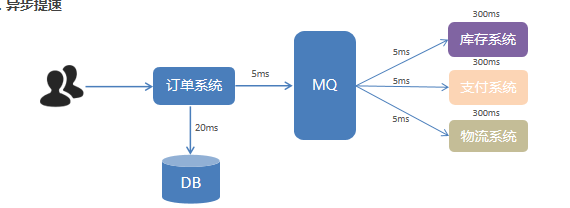
提升用户体验和系统吞吐量(单位时间内处理请求的数目)。
2、应用解耦:应用程序解耦合
MQ相当于一个中介,生产方通过MQ与消费方交互,它将应用程序进行解耦合。
之前:订单和其他系统之间的耦合性很高,
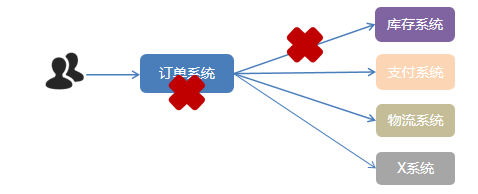
系统的耦合性越高,容错性就越低,可维护性就越低。
引入MQ之后:所有的请求都在MQ进行处理,再由MQ去请求各个模块
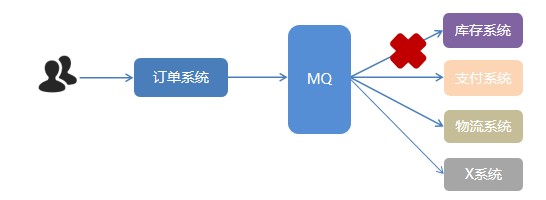
使用 MQ 使得应用间解耦,提升容错性和可维护性
3、削峰填谷
之前:
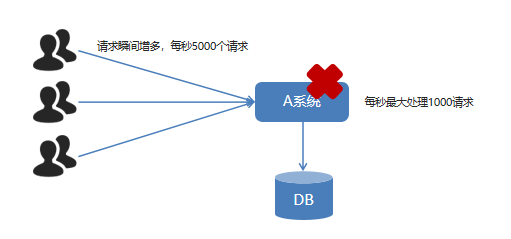
引入MQ之后:
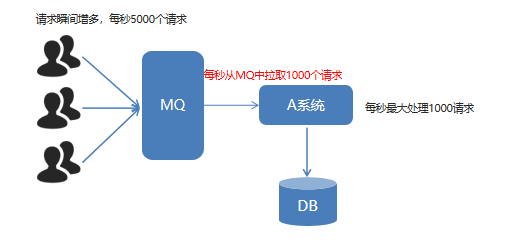

使用了 MQ 之后,限制消费消息的速度为1000,这样一来,高峰期产生的数据势必会被积压在 MQ 中,高峰就被“削”掉了,但是因为消息积压,在高峰期过后的一段时间内,消费消息的速度还是会维持在1000,直到消费完积压的消息,这就叫做“填谷”。
使用MQ后,可以提高系统稳定性。
实例
如订单系统,在下单的时候就会往数据库写数据。但是数据库只能支撑每秒1000左右的并发写入,并发量再高就容易宕机。低峰期的时候并发也就100多个,但是在高峰期时候,并发量会突然激增到5000以上,这个时候数据库肯定卡死了。

消息被MQ保存起来了,然后系统就可以按照自己的消费能力来消费,比如每秒1000个数据,这样慢慢写入数据库,这样就不会卡死数据库了。

但是使用了MQ之后,限制消费消息的速度为1000,但是这样一来,高峰期产生的数据势必会被积压在MQ中,高峰就被“削”掉了。但是因为消息积压,在高峰期过后的一段时间内,消费消息的速度还是会维持在1000QPS,直到消费完积压的消息,这就叫做“填谷”

总结
- 应用解耦:提高系统容错性和可维护性
- 异步提速:提升用户体验和系统吞吐量
- 削峰填谷:提高系统稳定性
缺点

系统可用性降低
系统引入的外部依赖越多,系统稳定性越差。一旦 MQ 宕机,就会对业务造成影响。如何保证MQ的高可用?
系统复杂度提高
MQ 的加入大大增加了系统的复杂度,以前系统间是同步的远程调用,现在是通过 MQ 进行异步调用。如何保证消息没有被重复消费?怎么处理消息丢失情况?那么保证消息传递的顺序性?
一致性问题
A 系统处理完业务,通过 MQ 给B、C、D三个系统发消息数据,如果 B 系统、C 系统处理成功,D 系统处理失败。如何保证消息数据处理的一致性?
总结
- 生产者不需要从消费者处获得反馈。引入消息队列之前的直接调用,其接口的返回值应该为空,这才让明明下层的动作还没做,上层却当成动作做完了继续往后走,即所谓异步成为了可能。
- 容许短暂的不一致性。
- 确实是用了有效果。即解耦、提速、削峰这些方面的收益,超过加入MQ,管理MQ这些成本
1.2. 消息队列产品
市场上常见的消息队列有如下:
- ActiveMQ:基于JMS
- ZeroMQ:基于C语言开发
- RabbitMQ:基于AMQP协议,erlang语言开发,稳定性好
- RocketMQ:基于JMS,阿里巴巴产品
- Kafka:类似MQ的产品;分布式消息系统,高吞吐量

1.3. AMQP 和 JMS
MQ是消息通信的模型;实现MQ的大致有两种主流方式:AMQP、JMS。
1.3.1. AMQP
AMQP,即 Advanced Message Queuing Protocol(高级消息队列协议),是一个网络协议,是应用层协议的一个开放标准,为面向消息的中间件设计。基于此协议的客户端与消息中间件可传递消息,并不受客户端/中间件不同产品,不同的开发语言等条件的限制。2006年,AMQP 规范发布。类比HTTP。
AMQP是一种协议,更准确的说是一种binary wire-level protocol(链接协议)。这是其和JMS的本质差别,AMQP不从API层进行限定,而是直接定义网络交换的数据格式。
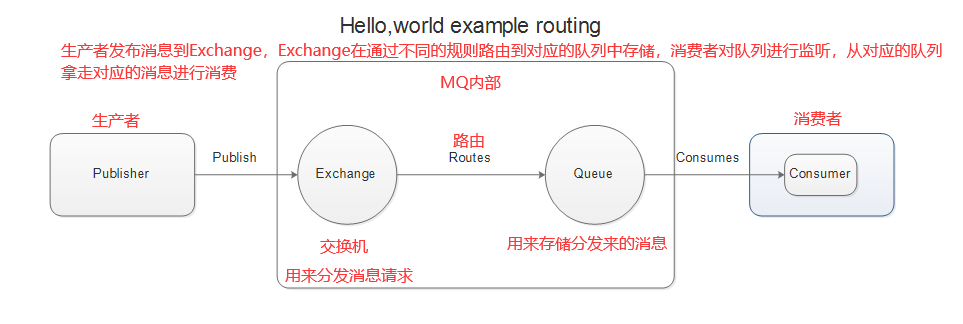
1.3.2. JMS
JMS即Java消息服务(JavaMessage Service)应用程序接口,是一个Java平台中关于面向消息中间件(MOM)的API,用于在两个应用程序之间,或分布式系统中发送消息,进行异步通信。
JMS 是 JavaEE 规范中的一种,类比JDBC
很多消息中间件都实现了JMS规范,例如:ActiveMQ。RabbitMQ 官方没有提供 JMS 的实现包,但是开源社区有
1.3.3. AMQP 与 JMS 区别
- JMS是定义了统一的接口,来对消息操作进行统一;AMQP是通过规定协议来统一数据交互的格式
- JMS限定了必须使用Java语言;AMQP只是协议,不规定实现方式,因此是跨语言的。
- JMS规定了两种消息模式;而AMQP的消息模式更加丰富
1.4. RabbitMQ
RabbitMQ官方地址:http://www.rabbitmq.com/
RabbitMQ是由erlang语言开发,基于AMQP(Advanced Message Queue 高级消息队列协议)协议实现的消息队列,它是一种应用程序之间的通信方法,消息队列在分布式系统开发中应用非常广泛。

相关概念:
- Broker:接收和分发消息的应用,RabbitMQ Server就是 Message Broker
- Virtual host:出于多租户和安全因素设计的,把 AMQP 的基本组件划分到一个虚拟的分组中,类似于网络中的 namespace 概念。当多个不同的用户使用同一个 RabbitMQ server 提供的服务时,可以划分出多个vhost,每个用户在自己的 vhost 创建 exchange/queue 等
- Connection:publisher/consumer 和 broker 之间的 TCP 连接
- Channel:如果每一次访问 RabbitMQ 都建立一个 Connection,在消息量大的时候建立 TCP Connection的开销将是巨大的,效率也较低。Channel 是在 connection 内部建立的逻辑连接,如果应用程序支持多线程,通常每个thread创建单独的 channel 进行通讯,AMQP method 包含了channel id 帮助客户端和message broker 识别 channel,所以 channel 之间是完全隔离的。Channel 作为轻量级的 Connection 极大减少了操作系统建立 TCP connection 的开销
- Exchange:message 到达 broker 的第一站,根据分发规则,匹配查询表中的 routing key,分发消息到queue 中去。常用的类型有:direct (point-to-point), topic (publish-subscribe) and fanout (multicast)
- Queue:消息最终被送到这里等待 consumer 取走
- Binding:exchange 和 queue 之间的虚拟连接,binding 中可以包含 routing key。Binding 信息被保存到 exchange 中的查询表中,用于 message 的分发依据
RabbitMQ提供了6种模式:简单模式,work模式,Publish/Subscribe发布与订阅模式,Routing路由模式,Topics主题模式,RPC远程调用模式(远程调用,不太算MQ;暂不作介绍);
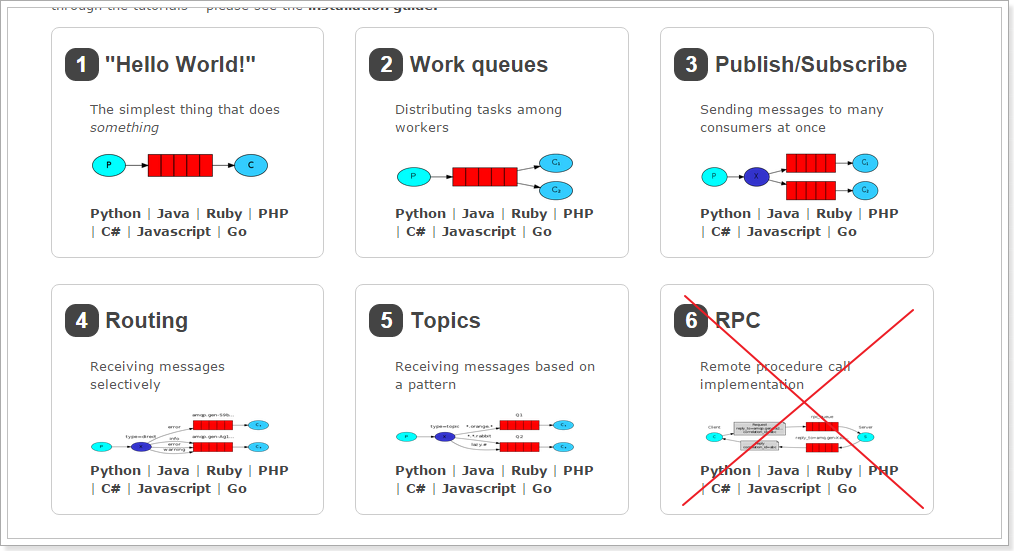
官网对应模式介绍:https://www.rabbitmq.com/getstarted.html
小结
- RabbitMQ 是基于 AMQP 协议使用 Erlang 语言开发的一款消息队列产品。
- RabbitMQ提供了6种工作模式,我们学习5种。这是今天的重点。
- AMQP 是协议,类比HTTP。
- JMS 是 API 规范接口,类比 JDBC。
2. 安装及配置RabbitMQ
详细查看 资料/软件/安装RabbitMQ.md 文档。
2.1.安装依赖环境
yum install build-essential openssl openssl-devel unixODBC unixODBC-devel make gcc gcc-c++ kernel-devel m4 ncurses-devel tk tc xz
|
2.2安装Erlang
上传
erlang-18.3-1.el7.centos.x86_64.rpm
socat-1.7.3.2-5.el7.lux.x86_64.rpm
rabbitmq-server-3.6.5-1.noarch.rpm
RabbitMQ安装时需要注意与Erlang的版本适配
# 安装
rpm -ivh erlang-18.3-1.el7.centos.x86_64.rpm
|
如果出现如下错误

说明gblic 版本太低。我们可以查看当前机器的gblic 版本
strings /lib64/libc.so.6 | grep GLIBC
|
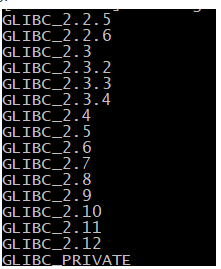
当前最高版本2.12,需要2.15.所以需要升级glibc
2.3.安装RabbitMQ
# 安装
rpm -ivh socat-1.7.3.2-5.el7.lux.x86_64.rpm
# 安装
rpm -ivh rabbitmq-server-3.6.5-1.noarch.rpm
|
2.4.开启管理界面及配置
# 开启管理界面
rabbitmq-plugins enable rabbitmq_management
# 修改默认配置信息
vim /usr/lib/rabbitmq/lib/rabbitmq_server-3.6.5/ebin/rabbit.app
# 比如修改密码、配置等等,例如:loopback_users 中的 <<"guest">>,只保留guest
|
2.5.启动
service rabbitmq-server start
service rabbitmq-server stop
service rabbitmq-server restart
|
cd /usr/share/doc/rabbitmq-server-3.6.5/
cp rabbitmq.config.example /etc/rabbitmq/rabbitmq.config
|
2.6.配置虚拟主机和用户
用户角色
RabbitMQ在安装好后,可以访问http://ip地址:15672 ;其自带了guest/guest的用户名和密码;如果需要创建自定义用户;那么也可以登录管理界面后,如下操作:
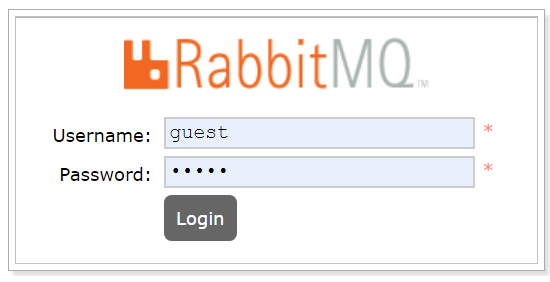

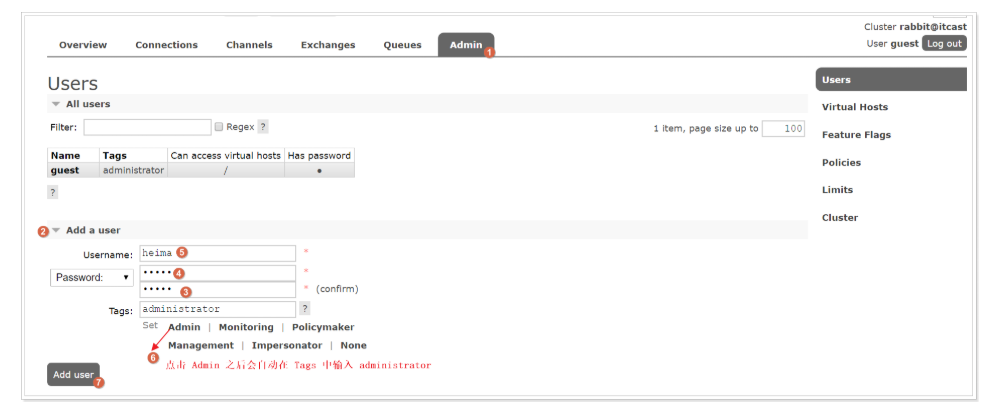
角色说明:
1、 超级管理员(administrator)
可登陆管理控制台,可查看所有的信息,并且可以对用户,策略(policy)进行操作。
2、 监控者(monitoring)
可登陆管理控制台,同时可以查看rabbitmq节点的相关信息(进程数,内存使用情况,磁盘使用情况等)
3、 策略制定者(policymaker)
可登陆管理控制台, 同时可以对policy进行管理。但无法查看节点的相关信息(上图红框标识的部分)。
4、 普通管理者(management)
仅可登陆管理控制台,无法看到节点信息,也无法对策略进行管理。
5、 其他
无法登陆管理控制台,通常就是普通的生产者和消费者。
Virtual Hosts配置
像mysql拥有数据库的概念并且可以指定用户对库和表等操作的权限。RabbitMQ也有类似的权限管理;在RabbitMQ中可以虚拟消息服务器Virtual Host,每个Virtual Hosts相当于一个相对独立的RabbitMQ服务器,每个VirtualHost之间是相互隔离的。exchange、queue、message不能互通。 相当于mysql的db。Virtual Name一般以/开头。
创建Virtual Hosts
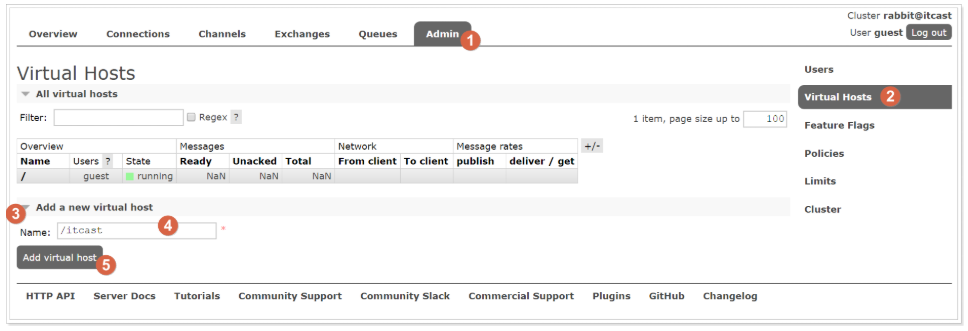
设置Virtual Hosts权限

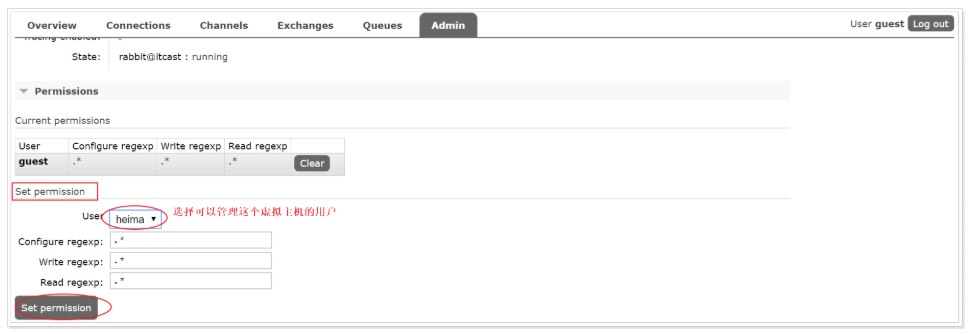
3. RabbitMQ入门
3.1. 搭建示例工程
3.1.1. 创建工程


3.1.2. 添加依赖
往heima-rabbitmq的pom.xml文件中添加如下依赖:
<dependency>
<groupId>com.rabbitmq</groupId>
<artifactId>amqp-client</artifactId>
<version>5.6.0</version>
</dependency>
|
3.2. 编写生产者
编写消息生产者com.itheima.rabbitmq.simple.Producer
package com.itheima.rabbitmq.simple;
import com.rabbitmq.client.Channel;
import com.rabbitmq.client.Connection;
import com.rabbitmq.client.ConnectionFactory;
public class Producer {
static final String QUEUE_NAME = "simple_queue";
public static void main(String[] args) throws Exception {
ConnectionFactory connectionFactory = new ConnectionFactory();
connectionFactory.setHost("localhost");
connectionFactory.setPort(5672);
connectionFactory.setVirtualHost("/itcast");
connectionFactory.setUsername("heima");
connectionFactory.setPassword("heima");
Connection connection = connectionFactory.newConnection();
Channel channel = connection.createChannel();
channel.queueDeclare(QUEUE_NAME, true, false, false, null);
String message = "你好;小兔子!";
channel.basicPublish("", QUEUE_NAME, null, message.getBytes());
System.out.println("已发送消息:" + message);
channel.close();
connection.close();
}
}
|
在执行上述的消息发送之后;可以登录rabbitMQ的管理控制台,可以发现队列和其消息:
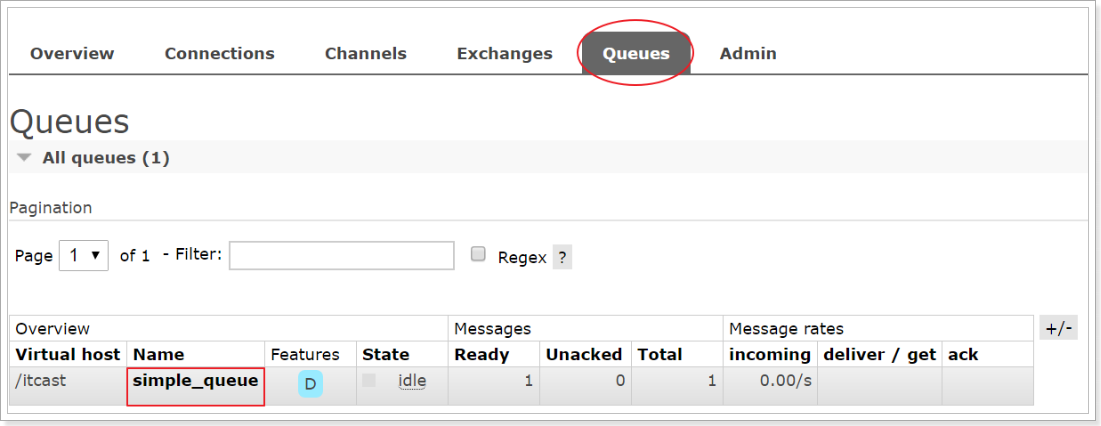
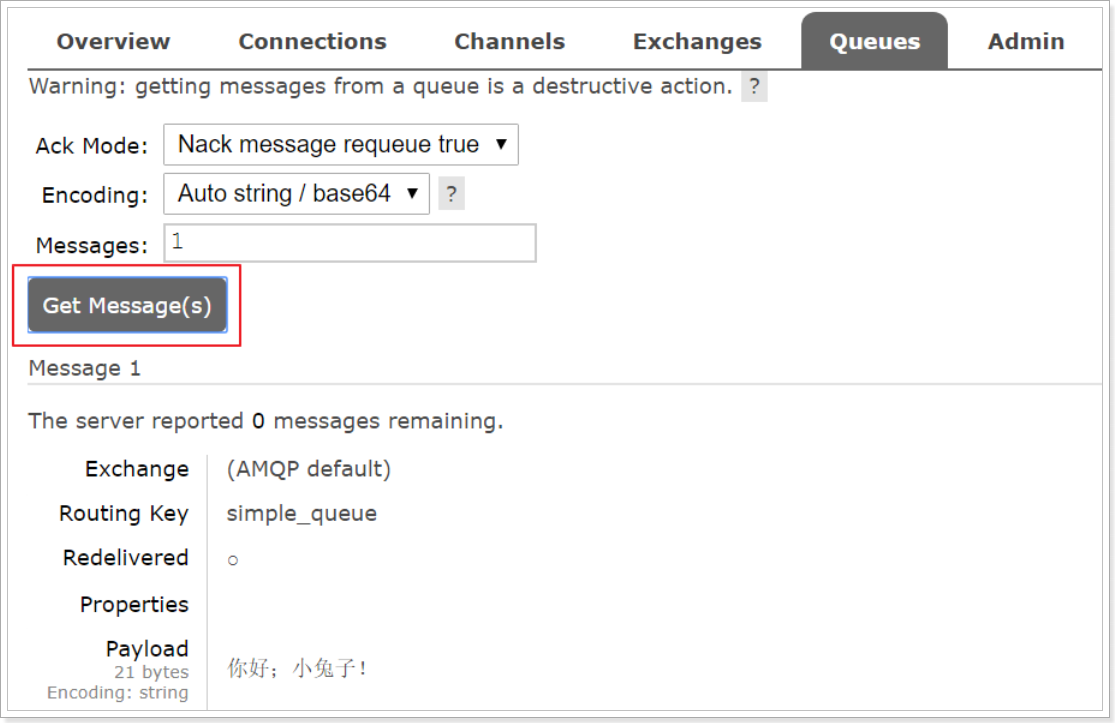
3.3. 编写消费者
抽取创建connection的工具类com.itheima.rabbitmq.util.ConnectionUtil;
package com.itheima.rabbitmq.util;
import com.rabbitmq.client.Connection;
import com.rabbitmq.client.ConnectionFactory;
public class ConnectionUtil {
public static Connection getConnection() throws Exception {
ConnectionFactory connectionFactory = new ConnectionFactory();
connectionFactory.setHost("localhost");
connectionFactory.setPort(5672);
connectionFactory.setVirtualHost("/itcast");
connectionFactory.setUsername("heima");
connectionFactory.setPassword("heima");
return connectionFactory.newConnection();
}
}
|
编写消息的消费者com.itheima.rabbitmq.simple.Consumer
package com.itheima.rabbitmq.simple;
import com.itheima.rabbitmq.util.ConnectionUtil;
import com.rabbitmq.client.*;
import java.io.IOException;
public class Consumer {
public static void main(String[] args) throws Exception {
Connection connection = ConnectionUtil.getConnection();
Channel channel = connection.createChannel();
channel.queueDeclare(Producer.QUEUE_NAME, true, false, false, null);
DefaultConsumer consumer = new DefaultConsumer(channel){
@Override
public void handleDelivery(String consumerTag, Envelope envelope, AMQP.BasicProperties properties, byte[] body) throws IOException {
System.out.println("路由key为:" + envelope.getRoutingKey());
System.out.println("交换机为:" + envelope.getExchange());
System.out.println("消息id为:" + envelope.getDeliveryTag());
System.out.println("接收到的消息为:" + new String(body, "utf-8"));
}
};
channel.basicConsume(Producer.QUEUE_NAME, true, consumer);
}
}
|
3.4. 小结
上述的入门案例中中其实使用的是如下的简单模式:

在上图的模型中,有以下概念:
- P:生产者,也就是要发送消息的程序
- C:消费者:消息的接受者,会一直等待消息到来。
- queue:消息队列,图中红色部分。类似一个邮箱,可以缓存消息;生产者向其中投递消息,消费者从其中取出消息。
4. RabbitMQ工作模式
不同的工作模式指的是消息间路由的策略和方式不同。
4.1. Work queues工作队列模式
4.1.1. 模式说明
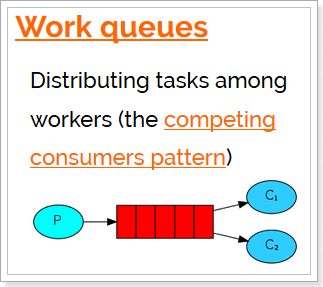
Work Queues与入门程序的简单模式相比,多了一个或一些消费端,多个消费端共同消费同一个队列中的消息。
应用场景:对于 任务过重或任务较多情况使用工作队列可以提高任务处理的速度。
4.1.2. 代码
Work Queues与入门程序的简单模式的代码是几乎一样的;可以完全复制,并复制多一个消费者进行多个消费者同时消费消息的测试。
1)生产者
package com.itheima.rabbitmq.work;
import com.itheima.rabbitmq.util.ConnectionUtil;
import com.rabbitmq.client.Channel;
import com.rabbitmq.client.Connection;
import com.rabbitmq.client.ConnectionFactory;
public class Producer {
static final String QUEUE_NAME = "work_queue";
public static void main(String[] args) throws Exception {
Connection connection = ConnectionUtil.getConnection();
Channel channel = connection.createChannel();
channel.queueDeclare(QUEUE_NAME, true, false, false, null);
for (int i = 1; i <= 30; i++) {
String message = "你好;小兔子!work模式--" + i;
channel.basicPublish("", QUEUE_NAME, null, message.getBytes());
System.out.println("已发送消息:" + message);
}
channel.close();
connection.close();
}
}
|
2)消费者1
package com.itheima.rabbitmq.work;
import com.itheima.rabbitmq.util.ConnectionUtil;
import com.rabbitmq.client.*;
import java.io.IOException;
public class Consumer1 {
public static void main(String[] args) throws Exception {
Connection connection = ConnectionUtil.getConnection();
Channel channel = connection.createChannel();
channel.queueDeclare(Producer.QUEUE_NAME, true, false, false, null);
channel.basicQos(1);
DefaultConsumer consumer = new DefaultConsumer(channel){
@Override
public void handleDelivery(String consumerTag, Envelope envelope, AMQP.BasicProperties properties, byte[] body) throws IOException {
try {
System.out.println("路由key为:" + envelope.getRoutingKey());
System.out.println("交换机为:" + envelope.getExchange());
System.out.println("消息id为:" + envelope.getDeliveryTag());
System.out.println("消费者1-接收到的消息为:" + new String(body, "utf-8"));
Thread.sleep(1000);
channel.basicAck(envelope.getDeliveryTag(), false);
} catch (InterruptedException e) {
e.printStackTrace();
}
}
};
channel.basicConsume(Producer.QUEUE_NAME, false, consumer);
}
}
|
3)消费者2
package com.itheima.rabbitmq.work;
import com.itheima.rabbitmq.util.ConnectionUtil;
import com.rabbitmq.client.*;
import java.io.IOException;
public class Consumer2 {
public static void main(String[] args) throws Exception {
Connection connection = ConnectionUtil.getConnection();
Channel channel = connection.createChannel();
channel.queueDeclare(Producer.QUEUE_NAME, true, false, false, null);
channel.basicQos(1);
DefaultConsumer consumer = new DefaultConsumer(channel){
@Override
public void handleDelivery(String consumerTag, Envelope envelope, AMQP.BasicProperties properties, byte[] body) throws IOException {
try {
System.out.println("路由key为:" + envelope.getRoutingKey());
System.out.println("交换机为:" + envelope.getExchange());
System.out.println("消息id为:" + envelope.getDeliveryTag());
System.out.println("消费者2-接收到的消息为:" + new String(body, "utf-8"));
Thread.sleep(1000);
channel.basicAck(envelope.getDeliveryTag(), false);
} catch (InterruptedException e) {
e.printStackTrace();
}
}
};
channel.basicConsume(Producer.QUEUE_NAME, false, consumer);
}
}
|
4.1.3. 测试
启动两个消费者,然后再启动生产者发送消息;到IDEA的两个消费者对应的控制台查看是否竞争性的接收到消息。
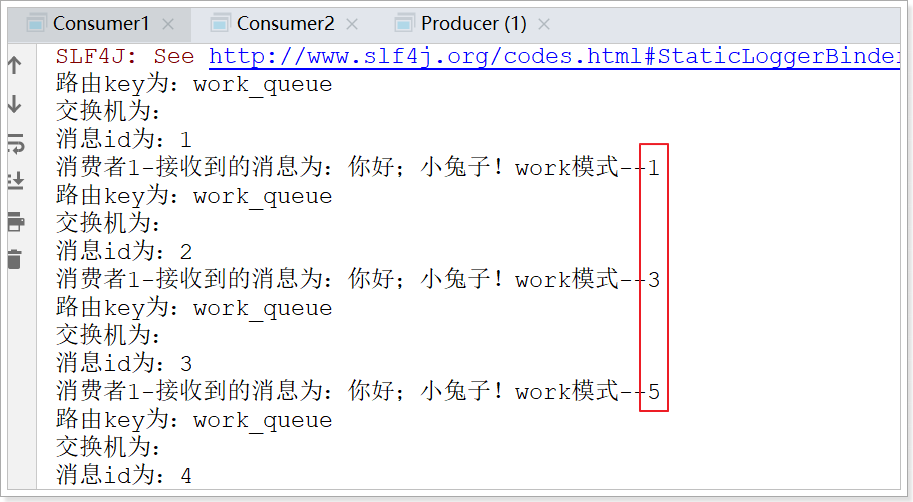
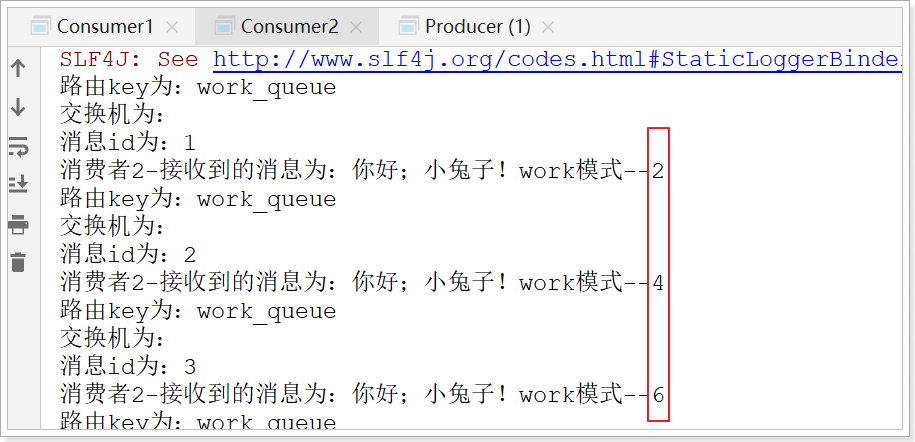
4.1.4. 小结
在一个队列中如果有多个消费者,那么消费者之间对于同一个消息的关系是竞争的关系。
Work Queues 对于任务过重或任务较多情况使用工作队列可以提高任务处理的速度。例如:短信服务部署多个,只需要有一个节点成功发送即可
4.2. 订阅模式类型
生产者把消息生产出来后交给交换机,交换机将内容路由分发给两个queue,消费者从queue中获取消息。
订阅模式示例图:

前面2个案例中,只有3个角色:
- P:生产者,也就是要发送消息的程序
- C:消费者:消息的接受者,会一直等待消息到来。
- queue:消息队列,图中红色部分
而在订阅模型中,多了一个exchange角色,而且过程略有变化:
- P:生产者,也就是要发送消息的程序,但是不再发送到队列中,而是发给X(交换机)
- C:消费者,消息的接受者,会一直等待消息到来。
- Queue:消息队列,接收消息、缓存消息。
- Exchange:交换机,图中的X。一方面,接收生产者发送的消息。另一方面,知道如何处理消息,例如递交给某个特别队列、递交给所有队列、或是将消息丢弃。到底如何操作,取决于Exchange的类型。Exchange有常见以下3种类型:
- Fanout:广播,将消息交给所有绑定到交换机的队列
- Direct:定向,把消息交给符合指定routing key 的队列
- Topic:通配符,把消息交给符合routing pattern(路由模式) 的队列
Exchange(交换机)只负责转发消息,不具备存储消息的能力,因此如果没有任何队列与Exchange绑定,或者没有符合路由规则的队列,那么消息会丢失!
4.3. Publish/Subscribe发布与订阅模式
4.3.1. 模式说明
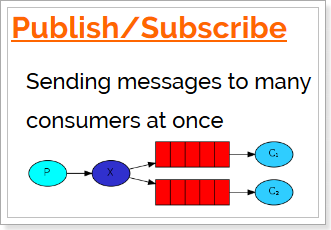
发布订阅模式:
1、每个消费者监听自己的队列。
2、生产者将消息发给broker,由交换机将消息转发到绑定此交换机的每个队列,每个绑定交换机的队列都将接收到消息
4.3.2. 代码
1)生产者
package com.itheima.rabbitmq.ps;
import com.itheima.rabbitmq.util.ConnectionUtil;
import com.rabbitmq.client.BuiltinExchangeType;
import com.rabbitmq.client.Channel;
import com.rabbitmq.client.Connection;
public class Producer {
static final String FANOUT_EXCHAGE = "fanout_exchange";
static final String FANOUT_QUEUE_1 = "fanout_queue_1";
static final String FANOUT_QUEUE_2 = "fanout_queue_2";
public static void main(String[] args) throws Exception {
Connection connection = ConnectionUtil.getConnection();
Channel channel = connection.createChannel();
channel.exchangeDeclare(FANOUT_EXCHAGE, BuiltinExchangeType.FANOUT);
channel.queueDeclare(FANOUT_QUEUE_1, true, false, false, null);
channel.queueDeclare(FANOUT_QUEUE_2, true, false, false, null);
channel.queueBind(FANOUT_QUEUE_1, FANOUT_EXCHAGE, "");
channel.queueBind(FANOUT_QUEUE_2, FANOUT_EXCHAGE, "");
for (int i = 1; i <= 10; i++) {
String message = "你好;小兔子!发布订阅模式--" + i;
channel.basicPublish(FANOUT_EXCHAGE, "", null, message.getBytes());
System.out.println("已发送消息:" + message);
}
channel.close();
connection.close();
}
}
|
2)消费者1
package com.itheima.rabbitmq.ps;
import com.itheima.rabbitmq.util.ConnectionUtil;
import com.rabbitmq.client.*;
import java.io.IOException;
public class Consumer1 {
public static void main(String[] args) throws Exception {
Connection connection = ConnectionUtil.getConnection();
Channel channel = connection.createChannel();
channel.exchangeDeclare(Producer.FANOUT_EXCHAGE, BuiltinExchangeType.FANOUT);
channel.queueDeclare(Producer.FANOUT_QUEUE_1, true, false, false, null);
channel.queueBind(Producer.FANOUT_QUEUE_1, Producer.FANOUT_EXCHAGE, "");
DefaultConsumer consumer = new DefaultConsumer(channel){
@Override
public void handleDelivery(String consumerTag, Envelope envelope, AMQP.BasicProperties properties, byte[] body) throws IOException {
System.out.println("路由key为:" + envelope.getRoutingKey());
System.out.println("交换机为:" + envelope.getExchange());
System.out.println("消息id为:" + envelope.getDeliveryTag());
System.out.println("消费者1-接收到的消息为:" + new String(body, "utf-8"));
}
};
channel.basicConsume(Producer.FANOUT_QUEUE_1, true, consumer);
}
}
|
3)消费者2
package com.itheima.rabbitmq.ps;
import com.itheima.rabbitmq.util.ConnectionUtil;
import com.rabbitmq.client.*;
import java.io.IOException;
public class Consumer2 {
public static void main(String[] args) throws Exception {
Connection connection = ConnectionUtil.getConnection();
Channel channel = connection.createChannel();
channel.exchangeDeclare(Producer.FANOUT_EXCHAGE, BuiltinExchangeType.FANOUT);
channel.queueDeclare(Producer.FANOUT_QUEUE_2, true, false, false, null);
channel.queueBind(Producer.FANOUT_QUEUE_2, Producer.FANOUT_EXCHAGE, "");
DefaultConsumer consumer = new DefaultConsumer(channel){
@Override
public void handleDelivery(String consumerTag, Envelope envelope, AMQP.BasicProperties properties, byte[] body) throws IOException {
System.out.println("路由key为:" + envelope.getRoutingKey());
System.out.println("交换机为:" + envelope.getExchange());
System.out.println("消息id为:" + envelope.getDeliveryTag());
System.out.println("消费者2-接收到的消息为:" + new String(body, "utf-8"));
}
};
channel.basicConsume(Producer.FANOUT_QUEUE_2, true, consumer);
}
}
|
4.3.3. 测试
启动所有消费者,然后使用生产者发送消息;在每个消费者对应的控制台可以查看到生产者发送的所有消息;到达广播的效果。
在执行完测试代码后,其实到RabbitMQ的管理后台找到Exchanges选项卡,点击 fanout_exchange 的交换机,可以查看到如下的绑定:
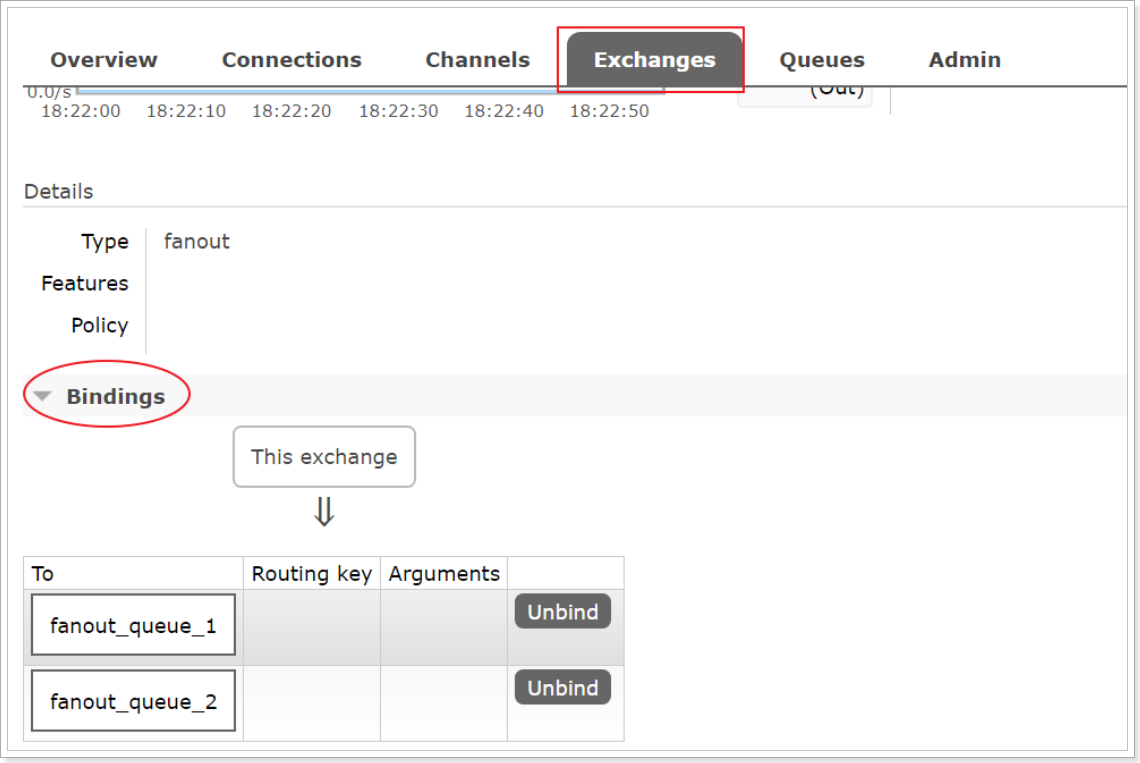
4.3.4. 小结
交换机需要与队列进行绑定,绑定之后;一个消息可以被多个消费者都收到。
发布订阅模式与工作队列模式的区别
1、工作队列模式不用定义交换机,而发布/订阅模式需要定义交换机。
2、发布/订阅模式的生产方是面向交换机发送消息,工作队列模式的生产方是面向队列发送消息(底层使用默认交换机)。
3、发布/订阅模式需要设置队列和交换机的绑定,工作队列模式不需要设置,实际上工作队列模式会将队列绑 定到默认的交换机 。
4.4. Routing路由模式
4.4.1. 模式说明
路由模式特点:
- 队列与交换机的绑定,不能是任意绑定了,而是要指定一个
RoutingKey(路由key)
- 消息的发送方在 向 Exchange发送消息时,也必须指定消息的
RoutingKey。
- Exchange不再把消息交给每一个绑定的队列,而是根据消息的
Routing Key进行判断,只有队列的Routingkey与消息的 Routing key完全一致,才会接收到消息
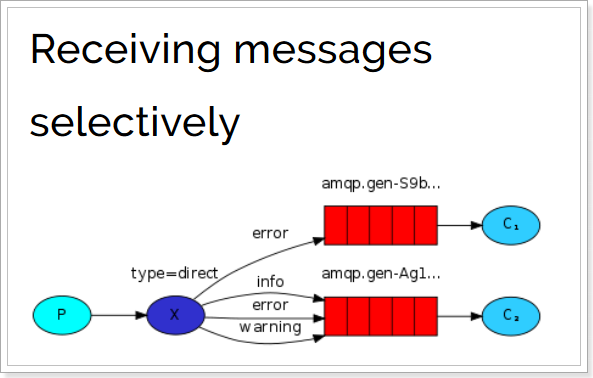
图解:
- P:生产者,向Exchange发送消息,发送消息时,会指定一个routing key。
- X:Exchange(交换机),接收生产者的消息,然后把消息递交给 与routing key完全匹配的队列
- C1:消费者,其所在队列指定了需要routing key 为 error 的消息
- C2:消费者,其所在队列指定了需要routing key 为 info、error、warning 的消息
4.4.2. 代码
在编码上与 Publish/Subscribe发布与订阅模式 的区别是交换机的类型为:Direct,还有队列绑定交换机的时候需要指定routing key。
1)生产者
package com.itheima.rabbitmq.routing;
import com.itheima.rabbitmq.util.ConnectionUtil;
import com.rabbitmq.client.BuiltinExchangeType;
import com.rabbitmq.client.Channel;
import com.rabbitmq.client.Connection;
public class Producer {
static final String DIRECT_EXCHAGE = "direct_exchange";
static final String DIRECT_QUEUE_INSERT = "direct_queue_insert";
static final String DIRECT_QUEUE_UPDATE = "direct_queue_update";
public static void main(String[] args) throws Exception {
Connection connection = ConnectionUtil.getConnection();
Channel channel = connection.createChannel();
channel.exchangeDeclare(DIRECT_EXCHAGE, BuiltinExchangeType.DIRECT);
channel.queueDeclare(DIRECT_QUEUE_INSERT, true, false, false, null);
channel.queueDeclare(DIRECT_QUEUE_UPDATE, true, false, false, null);
channel.queueBind(DIRECT_QUEUE_INSERT, DIRECT_EXCHAGE, "insert");
channel.queueBind(DIRECT_QUEUE_UPDATE, DIRECT_EXCHAGE, "update");
String message = "新增了商品。路由模式;routing key 为 insert " ;
channel.basicPublish(DIRECT_EXCHAGE, "insert", null, message.getBytes());
System.out.println("已发送消息:" + message);
message = "修改了商品。路由模式;routing key 为 update" ;
channel.basicPublish(DIRECT_EXCHAGE, "update", null, message.getBytes());
System.out.println("已发送消息:" + message);
channel.close();
connection.close();
}
}
|
2)消费者1
package com.itheima.rabbitmq.routing;
import com.itheima.rabbitmq.util.ConnectionUtil;
import com.rabbitmq.client.*;
import java.io.IOException;
public class Consumer1 {
public static void main(String[] args) throws Exception {
Connection connection = ConnectionUtil.getConnection();
Channel channel = connection.createChannel();
channel.exchangeDeclare(Producer.DIRECT_EXCHAGE, BuiltinExchangeType.DIRECT);
channel.queueDeclare(Producer.DIRECT_QUEUE_INSERT, true, false, false, null);
channel.queueBind(Producer.DIRECT_QUEUE_INSERT, Producer.DIRECT_EXCHAGE, "insert");
DefaultConsumer consumer = new DefaultConsumer(channel){
@Override
public void handleDelivery(String consumerTag, Envelope envelope, AMQP.BasicProperties properties, byte[] body) throws IOException {
System.out.println("路由key为:" + envelope.getRoutingKey());
System.out.println("交换机为:" + envelope.getExchange());
System.out.println("消息id为:" + envelope.getDeliveryTag());
System.out.println("消费者1-接收到的消息为:" + new String(body, "utf-8"));
}
};
channel.basicConsume(Producer.DIRECT_QUEUE_INSERT, true, consumer);
}
}
|
3)消费者2
package com.itheima.rabbitmq.routing;
import com.itheima.rabbitmq.util.ConnectionUtil;
import com.rabbitmq.client.*;
import java.io.IOException;
public class Consumer2 {
public static void main(String[] args) throws Exception {
Connection connection = ConnectionUtil.getConnection();
Channel channel = connection.createChannel();
channel.exchangeDeclare(Producer.DIRECT_EXCHAGE, BuiltinExchangeType.DIRECT);
channel.queueDeclare(Producer.DIRECT_QUEUE_UPDATE, true, false, false, null);
channel.queueBind(Producer.DIRECT_QUEUE_UPDATE, Producer.DIRECT_EXCHAGE, "update");
DefaultConsumer consumer = new DefaultConsumer(channel){
@Override
public void handleDelivery(String consumerTag, Envelope envelope, AMQP.BasicProperties properties, byte[] body) throws IOException {
System.out.println("路由key为:" + envelope.getRoutingKey());
System.out.println("交换机为:" + envelope.getExchange());
System.out.println("消息id为:" + envelope.getDeliveryTag());
System.out.println("消费者2-接收到的消息为:" + new String(body, "utf-8"));
}
};
channel.basicConsume(Producer.DIRECT_QUEUE_UPDATE, true, consumer);
}
}
|
4.4.3. 测试
启动所有消费者,然后使用生产者发送消息;在消费者对应的控制台可以查看到生产者发送对应routing key对应队列的消息;到达按照需要接收的效果。
在执行完测试代码后,其实到RabbitMQ的管理后台找到Exchanges选项卡,点击 direct_exchange 的交换机,可以查看到如下的绑定:
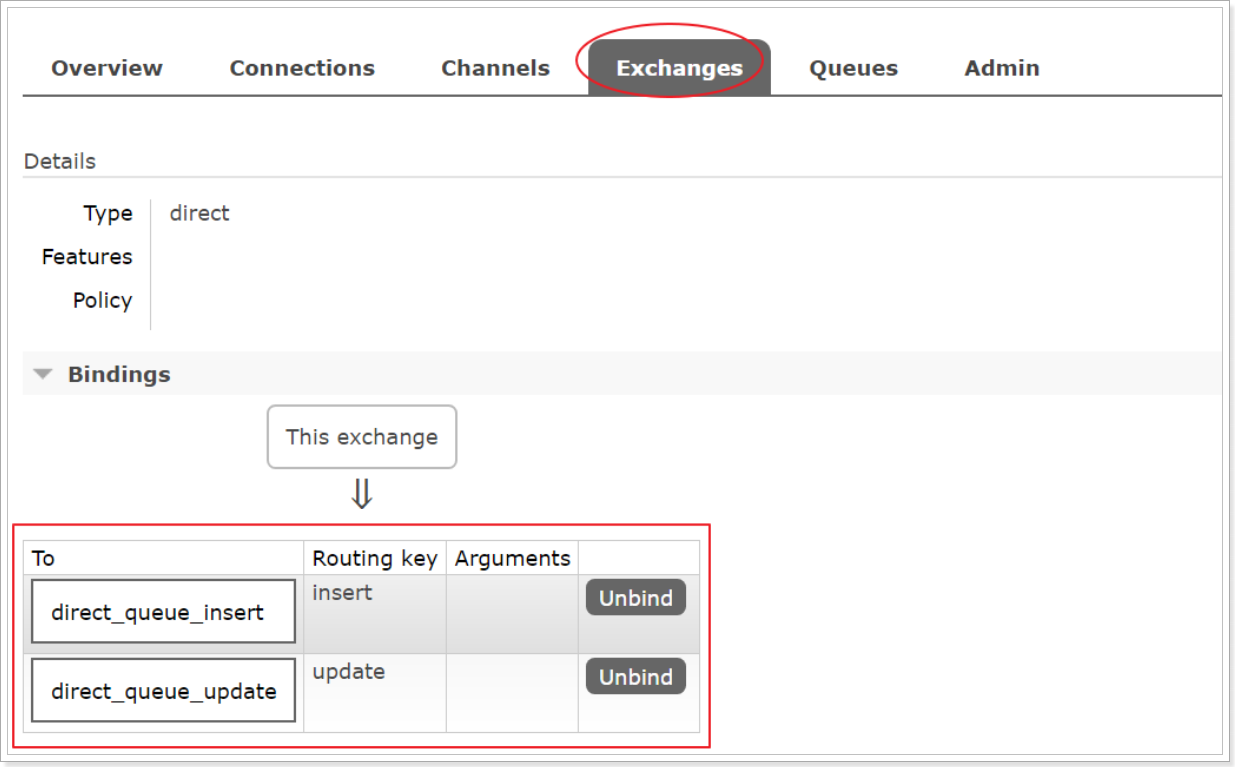
4.4.4. 小结
Routing模式要求队列在绑定交换机时要指定routing key,消息会转发到符合routing key的队列。
4.5. Topics通配符模式
4.5.1. 模式说明
Topic类型与Direct相比,都是可以根据RoutingKey把消息路由到不同的队列。只不过Topic类型Exchange可以让队列在绑定Routing key 的时候使用通配符!
Routingkey 一般都是有一个或多个单词组成,多个单词之间以”.”分割,例如: item.insert
通配符规则:
#:匹配一个或多个词
*:匹配不多不少恰好1个词
举例:
item.#:能够匹配item.insert.abc 或者 item.insert
item.*:只能匹配item.insert
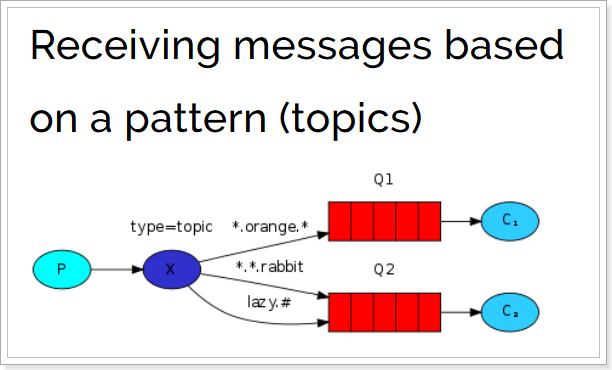
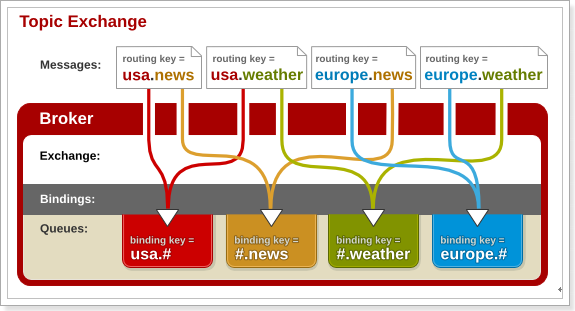
图解:
- 红色Queue:绑定的是
usa.# ,因此凡是以 usa.开头的routing key 都会被匹配到
- 黄色Queue:绑定的是
#.news ,因此凡是以 .news结尾的 routing key 都会被匹配
4.5.2. 代码
1)生产者
使用topic类型的Exchange,发送消息的routing key有3种: item.insert、item.update、item.delete:
package com.itheima.rabbitmq.topic;
import com.itheima.rabbitmq.util.ConnectionUtil;
import com.rabbitmq.client.BuiltinExchangeType;
import com.rabbitmq.client.Channel;
import com.rabbitmq.client.Connection;
public class Producer {
static final String TOPIC_EXCHAGE = "topic_exchange";
static final String TOPIC_QUEUE_1 = "topic_queue_1";
static final String TOPIC_QUEUE_2 = "topic_queue_2";
public static void main(String[] args) throws Exception {
Connection connection = ConnectionUtil.getConnection();
Channel channel = connection.createChannel();
channel.exchangeDeclare(TOPIC_EXCHAGE, BuiltinExchangeType.TOPIC);
String message = "新增了商品。Topic模式;routing key 为 item.insert " ;
channel.basicPublish(TOPIC_EXCHAGE, "item.insert", null, message.getBytes());
System.out.println("已发送消息:" + message);
message = "修改了商品。Topic模式;routing key 为 item.update" ;
channel.basicPublish(TOPIC_EXCHAGE, "item.update", null, message.getBytes());
System.out.println("已发送消息:" + message);
message = "删除了商品。Topic模式;routing key 为 item.delete" ;
channel.basicPublish(TOPIC_EXCHAGE, "item.delete", null, message.getBytes());
System.out.println("已发送消息:" + message);
channel.close();
connection.close();
}
}
|
2)消费者1
接收两种类型的消息:更新商品和删除商品
package com.itheima.rabbitmq.topic;
import com.itheima.rabbitmq.util.ConnectionUtil;
import com.rabbitmq.client.*;
import java.io.IOException;
public class Consumer1 {
public static void main(String[] args) throws Exception {
Connection connection = ConnectionUtil.getConnection();
Channel channel = connection.createChannel();
channel.exchangeDeclare(Producer.TOPIC_EXCHAGE, BuiltinExchangeType.TOPIC);
channel.queueDeclare(Producer.TOPIC_QUEUE_1, true, false, false, null);
channel.queueBind(Producer.TOPIC_QUEUE_1, Producer.TOPIC_EXCHAGE, "item.update");
channel.queueBind(Producer.TOPIC_QUEUE_1, Producer.TOPIC_EXCHAGE, "item.delete");
DefaultConsumer consumer = new DefaultConsumer(channel){
@Override
public void handleDelivery(String consumerTag, Envelope envelope, AMQP.BasicProperties properties, byte[] body) throws IOException {
System.out.println("路由key为:" + envelope.getRoutingKey());
System.out.println("交换机为:" + envelope.getExchange());
System.out.println("消息id为:" + envelope.getDeliveryTag());
System.out.println("消费者1-接收到的消息为:" + new String(body, "utf-8"));
}
};
channel.basicConsume(Producer.TOPIC_QUEUE_1, true, consumer);
}
}
|
3)消费者2
接收所有类型的消息:新增商品,更新商品和删除商品。
package com.itheima.rabbitmq.topic;
import com.itheima.rabbitmq.util.ConnectionUtil;
import com.rabbitmq.client.*;
import java.io.IOException;
public class Consumer2 {
public static void main(String[] args) throws Exception {
Connection connection = ConnectionUtil.getConnection();
Channel channel = connection.createChannel();
channel.exchangeDeclare(Producer.TOPIC_EXCHAGE, BuiltinExchangeType.TOPIC);
channel.queueDeclare(Producer.TOPIC_QUEUE_2, true, false, false, null);
channel.queueBind(Producer.TOPIC_QUEUE_2, Producer.TOPIC_EXCHAGE, "item.*");
DefaultConsumer consumer = new DefaultConsumer(channel){
@Override
public void handleDelivery(String consumerTag, Envelope envelope, AMQP.BasicProperties properties, byte[] body) throws IOException {
System.out.println("路由key为:" + envelope.getRoutingKey());
System.out.println("交换机为:" + envelope.getExchange());
System.out.println("消息id为:" + envelope.getDeliveryTag());
System.out.println("消费者2-接收到的消息为:" + new String(body, "utf-8"));
}
};
channel.basicConsume(Producer.TOPIC_QUEUE_2, true, consumer);
}
}
|
4.5.3. 测试
启动所有消费者,然后使用生产者发送消息;在消费者对应的控制台可以查看到生产者发送对应routing key对应队列的消息;到达按照需要接收的效果;并且这些routing key可以使用通配符。
在执行完测试代码后,其实到RabbitMQ的管理后台找到Exchanges选项卡,点击 topic_exchange 的交换机,可以查看到如下的绑定:
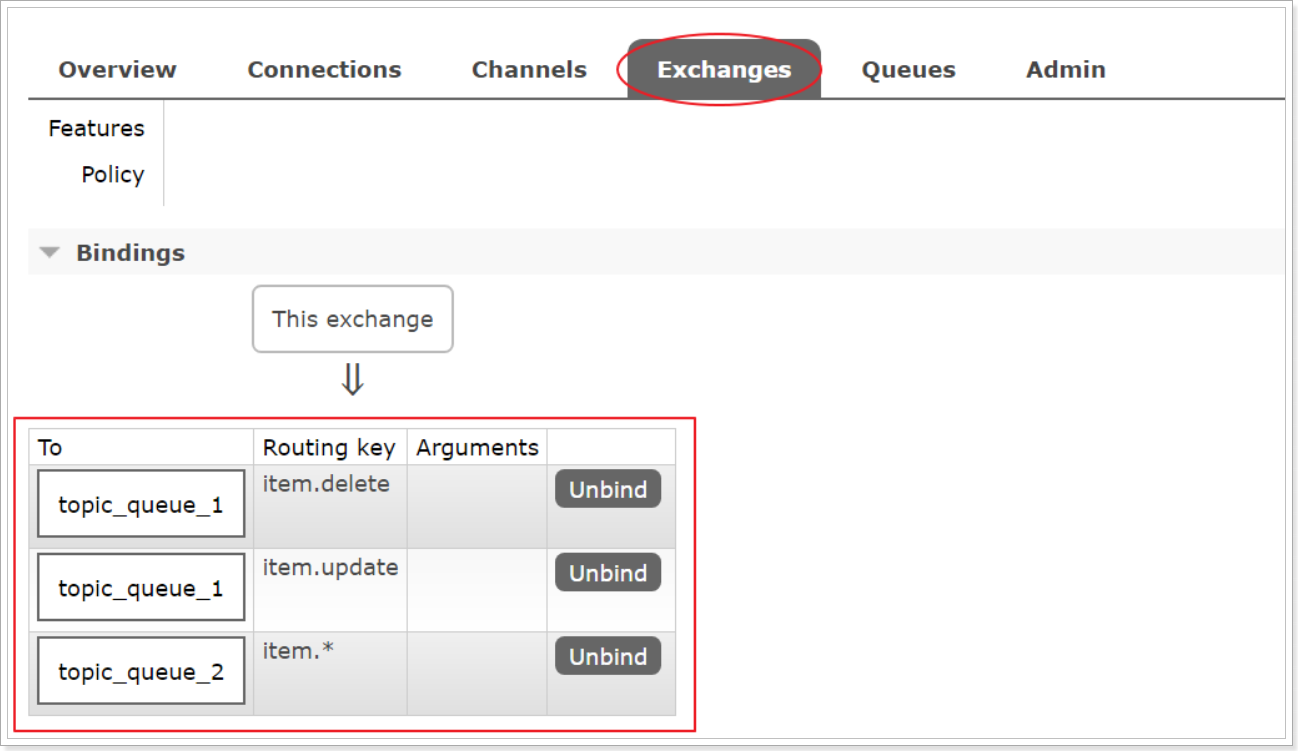
4.5.4.代码2
生产者
package com.itheima.producer;
import com.rabbitmq.client.BuiltinExchangeType;
import com.rabbitmq.client.Channel;
import com.rabbitmq.client.Connection;
import com.rabbitmq.client.ConnectionFactory;
import java.io.IOException;
import java.util.concurrent.TimeoutException;
public class Producer_Topics {
public static void main(String[] args) throws IOException, TimeoutException {
ConnectionFactory factory = new ConnectionFactory();
factory.setHost("172.16.98.133");
factory.setPort(5672);
factory.setVirtualHost("/itcast");
factory.setUsername("heima");
factory.setPassword("heima");
Connection connection = factory.newConnection();
Channel channel = connection.createChannel();
String exchangeName = "test_topic";
channel.exchangeDeclare(exchangeName, BuiltinExchangeType.TOPIC,true,false,false,null);
String queue1Name = "test_topic_queue1";
String queue2Name = "test_topic_queue2";
channel.queueDeclare(queue1Name,true,false,false,null);
channel.queueDeclare(queue2Name,true,false,false,null);
channel.queueBind(queue1Name,exchangeName,"#.error");
channel.queueBind(queue1Name,exchangeName,"order.*");
channel.queueBind(queue2Name,exchangeName,"*.*");
String body = "日志信息:张三调用了findAll方法...日志级别:info...";
channel.basicPublish(exchangeName,"goods.error",null,body.getBytes());
channel.close();
connection.close();
}
}
|
消费者
package com.itheima.consumer;
import com.rabbitmq.client.*;
import java.io.IOException;
import java.util.concurrent.TimeoutException;
public class Consumer_Topic1 {
public static void main(String[] args) throws IOException, TimeoutException {
ConnectionFactory factory = new ConnectionFactory();
factory.setHost("172.16.98.133");
factory.setPort(5672);
factory.setVirtualHost("/itcast");
factory.setUsername("heima");
factory.setPassword("heima");
Connection connection = factory.newConnection();
Channel channel = connection.createChannel();
String queue1Name = "test_topic_queue1";
String queue2Name = "test_topic_queue2";
Consumer consumer = new DefaultConsumer(channel){
@Override
public void handleDelivery(String consumerTag, Envelope envelope, AMQP.BasicProperties properties, byte[] body) throws IOException {
System.out.println("body:"+new String(body));
System.out.println("将日志信息存入数据库.......");
}
};
channel.basicConsume(queue1Name,true,consumer);
}
}
|
消费者
package com.itheima.consumer;
import com.rabbitmq.client.*;
import java.io.IOException;
import java.util.concurrent.TimeoutException;
public class Consumer_Topic2 {
public static void main(String[] args) throws IOException, TimeoutException {
ConnectionFactory factory = new ConnectionFactory();
factory.setHost("172.16.98.133");
factory.setPort(5672);
factory.setVirtualHost("/itcast");
factory.setUsername("heima");
factory.setPassword("heima");
Connection connection = factory.newConnection();
Channel channel = connection.createChannel();
String queue1Name = "test_topic_queue1";
String queue2Name = "test_topic_queue2";
Consumer consumer = new DefaultConsumer(channel){
@Override
public void handleDelivery(String consumerTag, Envelope envelope, AMQP.BasicProperties properties, byte[] body) throws IOException {
System.out.println("body:"+new String(body));
System.out.println("将日志信息打印控制台.......");
}
};
channel.basicConsume(queue2Name,true,consumer);
}
}
|
4.5.5. 小结
Topic主题模式可以实现 Publish/Subscribe发布与订阅模式 和 Routing路由模式 的功能;只是Topic在配置routing key 的时候可以使用通配符,显得更加灵活。
4.6. 模式总结
RabbitMQ工作模式:
1、简单模式 HelloWorld
一个生产者、一个消费者,不需要设置交换机(使用默认的交换机)
2、工作队列模式 Work Queue
一个生产者、多个消费者(竞争关系),不需要设置交换机(使用默认的交换机)
3、发布订阅模式 Publish/subscribe
需要设置类型为fanout的交换机,并且交换机和队列进行绑定,当发送消息到交换机后,交换机会将消息发送到绑定的队列
4、路由模式 Routing
需要设置类型为direct的交换机,交换机和队列进行绑定,并且指定routing key,当发送消息到交换机后,交换机会根据routing key将消息发送到对应的队列
5、通配符模式 Topic
需要设置类型为topic的交换机,交换机和队列进行绑定,并且指定通配符方式的routing key,当发送消息到交换机后,交换机会根据routing key将消息发送到对应的队列
5. Spring 整合RabbitMQ
5.1. 搭建生产者工程
5.1.1. 创建工程


5.1.2. 添加依赖
修改pom.xml文件内容为如下:
<?xml version="1.0" encoding="UTF-8"?>
<project xmlns="http://maven.apache.org/POM/4.0.0"
xmlns:xsi="http://www.w3.org/2001/XMLSchema-instance"
xsi:schemaLocation="http://maven.apache.org/POM/4.0.0 http://maven.apache.org/xsd/maven-4.0.0.xsd">
<modelVersion>4.0.0</modelVersion>
<groupId>com.itheima</groupId>
<artifactId>spring-rabbitmq-producer</artifactId>
<version>1.0-SNAPSHOT</version>
<dependencies>
<dependency>
<groupId>org.springframework</groupId>
<artifactId>spring-context</artifactId>
<version>5.1.7.RELEASE</version>
</dependency>
<dependency>
<groupId>org.springframework.amqp</groupId>
<artifactId>spring-rabbit</artifactId>
<version>2.1.8.RELEASE</version>
</dependency>
<dependency>
<groupId>junit</groupId>
<artifactId>junit</artifactId>
<version>4.12</version>
</dependency>
<dependency>
<groupId>org.springframework</groupId>
<artifactId>spring-test</artifactId>
<version>5.1.7.RELEASE</version>
</dependency>
</dependencies>
</project>
|
5.1.3. 配置整合
- 创建
spring-rabbitmq-producer\src\main\resources\properties\rabbitmq.properties连接参数等配置文件;
rabbitmq.host=192.168.12.135
rabbitmq.port=5672
rabbitmq.username=heima
rabbitmq.password=heima
rabbitmq.virtual-host=/itcast
|
- 创建
spring-rabbitmq-producer\src\main\resources\spring\spring-rabbitmq.xml 整合配置文件;
<?xml version="1.0" encoding="UTF-8"?>
<beans xmlns="http://www.springframework.org/schema/beans"
xmlns:xsi="http://www.w3.org/2001/XMLSchema-instance"
xmlns:context="http://www.springframework.org/schema/context"
xmlns:rabbit="http://www.springframework.org/schema/rabbit"
xsi:schemaLocation="http://www.springframework.org/schema/beans
http://www.springframework.org/schema/beans/spring-beans.xsd
http://www.springframework.org/schema/context
https://www.springframework.org/schema/context/spring-context.xsd
http://www.springframework.org/schema/rabbit
http://www.springframework.org/schema/rabbit/spring-rabbit.xsd">
<context:property-placeholder location="classpath:properties/rabbitmq.properties"/>
<rabbit:connection-factory id="connectionFactory" host="${rabbitmq.host}"
port="${rabbitmq.port}"
username="${rabbitmq.username}"
password="${rabbitmq.password}"
virtual-host="${rabbitmq.virtual-host}"/>
<rabbit:admin connection-factory="connectionFactory"/>
<rabbit:queue id="spring_queue" name="spring_queue" auto-declare="true"/>
<rabbit:queue id="spring_fanout_queue_1" name="spring_fanout_queue_1" auto-declare="true"/>
<rabbit:queue id="spring_fanout_queue_2" name="spring_fanout_queue_2" auto-declare="true"/>
<rabbit:fanout-exchange id="spring_fanout_exchange" name="spring_fanout_exchange" auto-declare="true">
<rabbit:bindings>
<rabbit:binding queue="spring_fanout_queue_1"/>
<rabbit:binding queue="spring_fanout_queue_2"/>
</rabbit:bindings>
</rabbit:fanout-exchange>
<rabbit:queue id="spring_topic_queue_star" name="spring_topic_queue_star" auto-declare="true"/>
<rabbit:queue id="spring_topic_queue_well" name="spring_topic_queue_well" auto-declare="true"/>
<rabbit:queue id="spring_topic_queue_well2" name="spring_topic_queue_well2" auto-declare="true"/>
<rabbit:topic-exchange id="spring_topic_exchange" name="spring_topic_exchange" auto-declare="true">
<rabbit:bindings>
<rabbit:binding pattern="heima.*" queue="spring_topic_queue_star"/>
<rabbit:binding pattern="heima.#" queue="spring_topic_queue_well"/>
<rabbit:binding pattern="itcast.#" queue="spring_topic_queue_well2"/>
</rabbit:bindings>
</rabbit:topic-exchange>
<rabbit:template id="rabbitTemplate" connection-factory="connectionFactory"/>
</beans>
|
5.1.4. 发送消息
创建测试文件 spring-rabbitmq-producer\src\test\java\com\itheima\rabbitmq\ProducerTest.java
@RunWith(SpringJUnit4ClassRunner.class)
@ContextConfiguration(locations = "classpath:spring/spring-rabbitmq.xml")
public class ProducerTest {
@Autowired
private RabbitTemplate rabbitTemplate;
@Test
public void queueTest(){
rabbitTemplate.convertAndSend("spring_queue", "只发队列spring_queue的消息。");
}
@Test
public void fanoutTest(){
rabbitTemplate.convertAndSend("spring_fanout_exchange", "", "发送到spring_fanout_exchange交换机的广播消息");
}
@Test
public void topicTest(){
rabbitTemplate.convertAndSend("spring_topic_exchange", "heima.bj", "发送到spring_topic_exchange交换机heima.bj的消息");
rabbitTemplate.convertAndSend("spring_topic_exchange", "heima.bj.1", "发送到spring_topic_exchange交换机heima.bj.1的消息");
rabbitTemplate.convertAndSend("spring_topic_exchange", "heima.bj.2", "发送到spring_topic_exchange交换机heima.bj.2的消息");
rabbitTemplate.convertAndSend("spring_topic_exchange", "itcast.cn", "发送到spring_topic_exchange交换机itcast.cn的消息");
}
}
|
5.2. 搭建消费者工程
5.2.1. 创建工程


5.2.2. 添加依赖
修改pom.xml文件内容为如下:
<?xml version="1.0" encoding="UTF-8"?>
<project xmlns="http://maven.apache.org/POM/4.0.0"
xmlns:xsi="http://www.w3.org/2001/XMLSchema-instance"
xsi:schemaLocation="http://maven.apache.org/POM/4.0.0 http://maven.apache.org/xsd/maven-4.0.0.xsd">
<modelVersion>4.0.0</modelVersion>
<groupId>com.itheima</groupId>
<artifactId>spring-rabbitmq-consumer</artifactId>
<version>1.0-SNAPSHOT</version>
<dependencies>
<dependency>
<groupId>org.springframework</groupId>
<artifactId>spring-context</artifactId>
<version>5.1.7.RELEASE</version>
</dependency>
<dependency>
<groupId>org.springframework.amqp</groupId>
<artifactId>spring-rabbit</artifactId>
<version>2.1.8.RELEASE</version>
</dependency>
</dependencies>
</project>
|
5.2.3. 配置整合
- 创建
spring-rabbitmq-consumer\src\main\resources\properties\rabbitmq.properties连接参数等配置文件;
rabbitmq.host=192.168.12.135
rabbitmq.port=5672
rabbitmq.username=heima
rabbitmq.password=heima
rabbitmq.virtual-host=/itcast
|
- 创建
spring-rabbitmq-consumer\src\main\resources\spring\spring-rabbitmq.xml 整合配置文件;
<?xml version="1.0" encoding="UTF-8"?>
<beans xmlns="http://www.springframework.org/schema/beans"
xmlns:xsi="http://www.w3.org/2001/XMLSchema-instance"
xmlns:context="http://www.springframework.org/schema/context"
xmlns:rabbit="http://www.springframework.org/schema/rabbit"
xsi:schemaLocation="http://www.springframework.org/schema/beans
http://www.springframework.org/schema/beans/spring-beans.xsd
http://www.springframework.org/schema/context
https://www.springframework.org/schema/context/spring-context.xsd
http://www.springframework.org/schema/rabbit
http://www.springframework.org/schema/rabbit/spring-rabbit.xsd">
<context:property-placeholder location="classpath:properties/rabbitmq.properties"/>
<rabbit:connection-factory id="connectionFactory" host="${rabbitmq.host}"
port="${rabbitmq.port}"
username="${rabbitmq.username}"
password="${rabbitmq.password}"
virtual-host="${rabbitmq.virtual-host}"/>
<bean id="springQueueListener" class="com.itheima.rabbitmq.listener.SpringQueueListener"/>
<bean id="fanoutListener1" class="com.itheima.rabbitmq.listener.FanoutListener1"/>
<bean id="fanoutListener2" class="com.itheima.rabbitmq.listener.FanoutListener2"/>
<bean id="topicListenerStar" class="com.itheima.rabbitmq.listener.TopicListenerStar"/>
<bean id="topicListenerWell" class="com.itheima.rabbitmq.listener.TopicListenerWell"/>
<bean id="topicListenerWell2" class="com.itheima.rabbitmq.listener.TopicListenerWell2"/>
<rabbit:listener-container connection-factory="connectionFactory" auto-declare="true">
<rabbit:listener ref="springQueueListener" queue-names="spring_queue"/>
<rabbit:listener ref="fanoutListener1" queue-names="spring_fanout_queue_1"/>
<rabbit:listener ref="fanoutListener2" queue-names="spring_fanout_queue_2"/>
<rabbit:listener ref="topicListenerStar" queue-names="spring_topic_queue_star"/>
<rabbit:listener ref="topicListenerWell" queue-names="spring_topic_queue_well"/>
<rabbit:listener ref="topicListenerWell2" queue-names="spring_topic_queue_well2"/>
</rabbit:listener-container>
</beans>
|
5.2.4. 消息监听器
1)队列监听器
创建 spring-rabbitmq-consumer\src\main\java\com\itheima\rabbitmq\listener\SpringQueueListener.java
public class SpringQueueListener implements MessageListener {
public void onMessage(Message message) {
try {
String msg = new String(message.getBody(), "utf-8");
System.out.printf("接收路由名称为:%s,路由键为:%s,队列名为:%s的消息:%s \n",
message.getMessageProperties().getReceivedExchange(),
message.getMessageProperties().getReceivedRoutingKey(),
message.getMessageProperties().getConsumerQueue(),
msg);
} catch (Exception e) {
e.printStackTrace();
}
}
}
|
2)广播监听器1
创建 spring-rabbitmq-consumer\src\main\java\com\itheima\rabbitmq\listener\FanoutListener1.java
public class FanoutListener1 implements MessageListener {
public void onMessage(Message message) {
try {
String msg = new String(message.getBody(), "utf-8");
System.out.printf("广播监听器1:接收路由名称为:%s,路由键为:%s,队列名为:%s的消息:%s \n",
message.getMessageProperties().getReceivedExchange(),
message.getMessageProperties().getReceivedRoutingKey(),
message.getMessageProperties().getConsumerQueue(),
msg);
} catch (Exception e) {
e.printStackTrace();
}
}
}
|
3)广播监听器2
创建 spring-rabbitmq-consumer\src\main\java\com\itheima\rabbitmq\listener\FanoutListener2.java
public class FanoutListener2 implements MessageListener {
public void onMessage(Message message) {
try {
String msg = new String(message.getBody(), "utf-8");
System.out.printf("广播监听器2:接收路由名称为:%s,路由键为:%s,队列名为:%s的消息:%s \n",
message.getMessageProperties().getReceivedExchange(),
message.getMessageProperties().getReceivedRoutingKey(),
message.getMessageProperties().getConsumerQueue(),
msg);
} catch (Exception e) {
e.printStackTrace();
}
}
}
|
4)星号通配符监听器
创建 spring-rabbitmq-consumer\src\main\java\com\itheima\rabbitmq\listener\TopicListenerStar.java
public class TopicListenerStar implements MessageListener {
public void onMessage(Message message) {
try {
String msg = new String(message.getBody(), "utf-8");
System.out.printf("通配符*监听器:接收路由名称为:%s,路由键为:%s,队列名为:%s的消息:%s \n",
message.getMessageProperties().getReceivedExchange(),
message.getMessageProperties().getReceivedRoutingKey(),
message.getMessageProperties().getConsumerQueue(),
msg);
} catch (Exception e) {
e.printStackTrace();
}
}
}
|
5)井号通配符监听器
创建 spring-rabbitmq-consumer\src\main\java\com\itheima\rabbitmq\listener\TopicListenerWell.java
public class TopicListenerWell implements MessageListener {
public void onMessage(Message message) {
try {
String msg = new String(message.getBody(), "utf-8");
System.out.printf("通配符#监听器:接收路由名称为:%s,路由键为:%s,队列名为:%s的消息:%s \n",
message.getMessageProperties().getReceivedExchange(),
message.getMessageProperties().getReceivedRoutingKey(),
message.getMessageProperties().getConsumerQueue(),
msg);
} catch (Exception e) {
e.printStackTrace();
}
}
}
|
6)井号通配符监听器2
创建 spring-rabbitmq-consumer\src\main\java\com\itheima\rabbitmq\listener\TopicListenerWell2.java
public class TopicListenerWell2 implements MessageListener {
public void onMessage(Message message) {
try {
String msg = new String(message.getBody(), "utf-8");
System.out.printf("通配符#监听器2:接收路由名称为:%s,路由键为:%s,队列名为:%s的消息:%s \n",
message.getMessageProperties().getReceivedExchange(),
message.getMessageProperties().getReceivedRoutingKey(),
message.getMessageProperties().getConsumerQueue(),
msg);
} catch (Exception e) {
e.printStackTrace();
}
}
}
|
6. Spring Boot整合RabbitMQ
6.1. 简介
在Spring项目中,可以使用Spring-Rabbit去操作RabbitMQ
https://github.com/spring-projects/spring-amqp
尤其是在spring boot项目中只需要引入对应的amqp启动器依赖即可,方便的使用RabbitTemplate发送消息,使用注解接收消息。
一般在开发过程中:
生产者工程:
application.yml文件配置RabbitMQ相关信息;
在生产者工程中编写配置类,用于创建交换机和队列,并进行绑定
注入RabbitTemplate对象,通过RabbitTemplate对象发送消息到交换机
消费者工程:
application.yml文件配置RabbitMQ相关信息
创建消息处理类,用于接收队列中的消息并进行处理
6.2. 搭建生产者工程
6.2.1. 创建工程
创建生产者工程springboot-rabbitmq-producer


6.2.2. 添加依赖
修改pom.xml文件内容为如下:
<?xml version="1.0" encoding="UTF-8"?>
<project xmlns="http://maven.apache.org/POM/4.0.0"
xmlns:xsi="http://www.w3.org/2001/XMLSchema-instance"
xsi:schemaLocation="http://maven.apache.org/POM/4.0.0 http://maven.apache.org/xsd/maven-4.0.0.xsd">
<modelVersion>4.0.0</modelVersion>
<parent>
<groupId>org.springframework.boot</groupId>
<artifactId>spring-boot-starter-parent</artifactId>
<version>2.1.4.RELEASE</version>
</parent>
<groupId>com.itheima</groupId>
<artifactId>springboot-rabbitmq-producer</artifactId>
<version>1.0-SNAPSHOT</version>
<dependencies>
<dependency>
<groupId>org.springframework.boot</groupId>
<artifactId>spring-boot-starter-amqp</artifactId>
</dependency>
<dependency>
<groupId>org.springframework.boot</groupId>
<artifactId>spring-boot-starter-test</artifactId>
</dependency>
</dependencies>
</project>
|
6.2.3. 启动类
package com.itheima.rabbitmq;
import org.springframework.boot.SpringApplication;
import org.springframework.boot.autoconfigure.SpringBootApplication;
@SpringBootApplication
public class ProducerApplication {
public static void main(String[] args) {
SpringApplication.run(ProducerApplication.class);
}
}
|
6.2.4. 配置RabbitMQ
1)配置文件
创建application.yml,内容如下:
spring:
rabbitmq:
host: localhost
port: 5672
virtual-host: /itcast
username: heima
password: heima
|
2)绑定交换机和队列
创建RabbitMQ队列与交换机绑定的配置类com.itheima.rabbitmq.config.RabbitMQConfig
package com.itheima.rabbitmq.config;
import org.springframework.amqp.core.*;
import org.springframework.beans.factory.annotation.Qualifier;
import org.springframework.context.annotation.Bean;
import org.springframework.context.annotation.Configuration;
@Configuration
public class RabbitMQConfig {
public static final String ITEM_TOPIC_EXCHANGE = "item_topic_exchange";
public static final String ITEM_QUEUE = "item_queue";
@Bean("itemTopicExchange")
public Exchange topicExchange(){
return ExchangeBuilder.topicExchange(ITEM_TOPIC_EXCHANGE).durable(true).build();
}
@Bean("itemQueue")
public Queue itemQueue(){
return QueueBuilder.durable(ITEM_QUEUE).build();
}
@Bean
public Binding itemQueueExchange(@Qualifier("itemQueue") Queue queue,
@Qualifier("itemTopicExchange") Exchange exchange){
return BindingBuilder.bind(queue).to(exchange).with("item.#").noargs();
}
}
|
6.2.5. 测试类
import org.junit.Test;
import org.junit.runner.RunWith;
import org.springframework.amqp.rabbit.core.RabbitTemplate;
import org.springframework.beans.factory.annotation.Autowired;
import org.springframework.test.context.ContextConfiguration;
import org.springframework.test.context.junit4.SpringJUnit4ClassRunner;
@RunWith(SpringJUnit4ClassRunner.class)
public class ProducerTest {
@Autowired
private RabbitTemplate rabbitTemplate;
@Test
public void testHelloWorld(){
rabbitTemplate.convertAndSend(RabbitMQConfig.EXECHANGE_NAME,"item.haha","boot mq hello~~");
}
}
|
6.3. 搭建消费者工程
6.3.1. 创建工程
创建消费者工程springboot-rabbitmq-consumer


6.3.2. 添加依赖
修改pom.xml文件内容为如下:
<?xml version="1.0" encoding="UTF-8"?>
<project xmlns="http://maven.apache.org/POM/4.0.0"
xmlns:xsi="http://www.w3.org/2001/XMLSchema-instance"
xsi:schemaLocation="http://maven.apache.org/POM/4.0.0 http://maven.apache.org/xsd/maven-4.0.0.xsd">
<modelVersion>4.0.0</modelVersion>
<parent>
<groupId>org.springframework.boot</groupId>
<artifactId>spring-boot-starter-parent</artifactId>
<version>2.1.4.RELEASE</version>
</parent>
<groupId>com.itheima</groupId>
<artifactId>springboot-rabbitmq-consumer</artifactId>
<version>1.0-SNAPSHOT</version>
<dependencies>
<dependency>
<groupId>org.springframework.boot</groupId>
<artifactId>spring-boot-starter-amqp</artifactId>
</dependency>
</dependencies>
</project>
|
6.3.3. 启动类
package com.itheima.rabbitmq;
import org.springframework.boot.SpringApplication;
import org.springframework.boot.autoconfigure.SpringBootApplication;
@SpringBootApplication
public class ConsumerApplication {
public static void main(String[] args) {
SpringApplication.run(ConsumerApplication.class);
}
}
|
6.3.4. 配置RabbitMQ
创建application.yml,内容如下:
spring:
rabbitmq:
host: localhost
port: 5672
virtual-host: /itcast
username: heima
password: heima
|
6.3.5. 消息监听处理类
编写消息监听器com.itheima.rabbitmq.listener.MyListener
package com.itheima.rabbitmq.listener;
import org.springframework.amqp.rabbit.annotation.RabbitListener;
import org.springframework.stereotype.Component;
@Component
public class MyListener {
@RabbitListener(queues = "item_queue")
public void myListener1(String message){
System.out.println("消费者接收到的消息为:" + message);
}
}
|
6.4. 测试
在生产者工程springboot-rabbitmq-producer中创建测试类,发送消息:
package com.itheima.rabbitmq;
import com.itheima.rabbitmq.config.RabbitMQConfig;
import org.junit.Test;
import org.junit.runner.RunWith;
import org.springframework.amqp.rabbit.core.RabbitTemplate;
import org.springframework.beans.factory.annotation.Autowired;
import org.springframework.boot.test.context.SpringBootTest;
import org.springframework.test.context.junit4.SpringRunner;
@RunWith(SpringRunner.class)
@SpringBootTest
public class RabbitMQTest {
@Autowired
private RabbitTemplate rabbitTemplate;
@Test
public void test(){
rabbitTemplate.convertAndSend(RabbitMQConfig.ITEM_TOPIC_EXCHANGE, "item.insert", "商品新增,routing key 为item.insert");
rabbitTemplate.convertAndSend(RabbitMQConfig.ITEM_TOPIC_EXCHANGE, "item.update", "商品修改,routing key 为item.update");
rabbitTemplate.convertAndSend(RabbitMQConfig.ITEM_TOPIC_EXCHANGE, "item.delete", "商品删除,routing key 为item.delete");
}
}
|
先运行上述测试程序(交换机和队列才能先被声明和绑定),然后启动消费者;在消费者工程springboot-rabbitmq-consumer中控制台查看是否接收到对应消息。
另外;也可以在RabbitMQ的管理控制台中查看到交换机与队列的绑定:
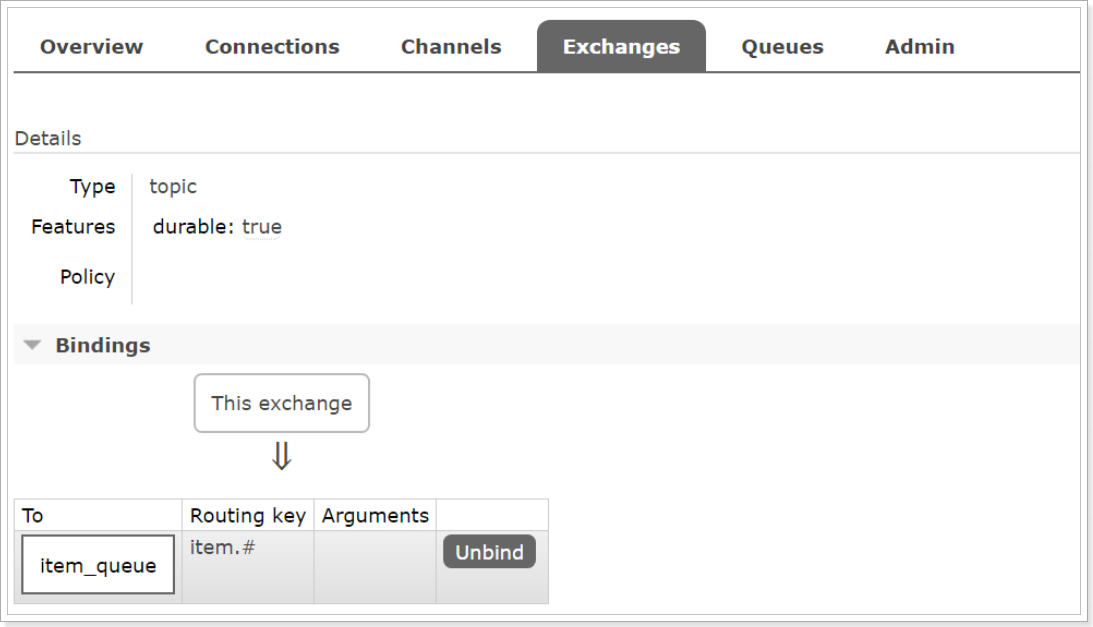
小结
SpringBoot提供了快速整合RabbitMQ的方式
基本信息在yml中配置,队列交互机以及绑定关系在配置类中使用Bean的方式配置
生产端直接注入RabbitTemplate完成消息发送
消费端直接使用@ RabbitL istener完成消息接收
AMQP(补充)
相关概念介绍
AMQP 一个提供统一消息服务的应用层标准高级消息队列协议,是应用层协议的一个开放标准,为面向消息的中间件设计。
AMQP是一个二进制协议,拥有一些现代化特点:多信道、协商式,异步,安全,扩平台,中立,高效。
RabbitMQ是AMQP协议的Erlang的实现。
| 概念 |
说明 |
| 连接Connection |
一个网络连接,比如TCP/IP套接字连接。 |
| 会话Session |
端点之间的命名对话。在一个会话上下文中,保证“恰好传递一次”。 |
| 信道Channel |
多路复用连接中的一条独立的双向数据流通道。为会话提供物理传输介质。 |
| 客户端Client |
AMQP连接或者会话的发起者。AMQP是非对称的,客户端生产和消费消息,服务器存储和路由这些消息。 |
| 服务节点Broker |
消息中间件的服务节点;一般情况下可以将一个RabbitMQ Broker看作一台RabbitMQ 服务器。 |
| 端点 |
AMQP对话的任意一方。一个AMQP连接包括两个端点(一个是客户端,一个是服务器)。 |
| 消费者Consumer |
一个从消息队列里请求消息的客户端程序。 |
| 生产者Producer |
一个向交换机发布消息的客户端应用程序。 |
RabbitMQ运转流程
在入门案例中:
- 生产者发送消息
- 生产者创建连接(Connection),开启一个信道(Channel),连接到RabbitMQ Broker;
- 声明队列并设置属性;如是否排它,是否持久化,是否自动删除;
- 将路由键(空字符串)与队列绑定起来;
- 发送消息至RabbitMQ Broker;
- 关闭信道;
- 关闭连接;
- 消费者接收消息
- 消费者创建连接(Connection),开启一个信道(Channel),连接到RabbitMQ Broker
- 向Broker 请求消费相应队列中的消息,设置相应的回调函数;
- 等待Broker回应闭关投递响应队列中的消息,消费者接收消息;
- 确认(ack,自动确认)接收到的消息;
- RabbitMQ从队列中删除相应已经被确认的消息;
- 关闭信道;
- 关闭连接;

生产者流转过程说明
- 客户端与代理服务器Broker建立连接。会调用newConnection() 方法,这个方法会进一步封装Protocol Header 0-9-1 的报文头发送给Broker ,以此通知Broker 本次交互采用的是AMQPO-9-1 协议,紧接着Broker 返回Connection.Start 来建立连接,在连接的过程中涉及Connection.Start/.Start-OK 、Connection.Tune/.Tune-Ok ,Connection.Open/ .Open-Ok 这6 个命令的交互。
- 客户端调用connection.createChannel方法。此方法开启信道,其包装的channel.open命令发送给Broker,等待channel.basicPublish方法,对应的AMQP命令为Basic.Publish,这个命令包含了content Header 和content Body()。content Header 包含了消息体的属性,例如:投递模式,优先级等,content Body 包含了消息体本身。
- 客户端发送完消息需要关闭资源时,涉及到Channel.Close和Channl.Close-Ok 与Connetion.Close和Connection.Close-Ok的命令交互。

消费者流转过程说明
消费者客户端与代理服务器Broker建立连接。会调用newConnection() 方法,这个方法会进一步封装Protocol Header 0-9-1 的报文头发送给Broker ,以此通知Broker 本次交互采用的是AMQPO-9-1 协议,紧接着Broker 返回Connection.Start 来建立连接,在连接的过程中涉及Connection.Start/.Start-OK 、Connection.Tune/.Tune-Ok ,Connection.Open/ .Open-Ok 这6 个命令的交互。
消费者客户端调用connection.createChannel方法。和生产者客户端一样,协议涉及Channel . Open/Open-Ok命令。
在真正消费之前,消费者客户端需要向Broker 发送Basic.Consume 命令(即调用channel.basicConsume 方法〉将Channel 置为接收模式,之后Broker 回执Basic . Consume - Ok 以告诉消费者客户端准备好消费消息。
Broker 向消费者客户端推送(Push) 消息,即Basic.Deliver 命令,这个命令和Basic.Publish 命令一样会携带Content Header 和Content Body。
消费者接收到消息并正确消费之后,向Broker 发送确认,即Basic.Ack 命令。
客户端发送完消息需要关闭资源时,涉及到Channel.Close和Channl.Close-Ok 与Connetion.Close和Connection.Close-Ok的命令交互。

7.RabbitMQ高级特性
准备工作
配置文件——producer
<?xml version="1.0" encoding="UTF-8"?>
<beans xmlns="http://www.springframework.org/schema/beans"
xmlns:xsi="http://www.w3.org/2001/XMLSchema-instance"
xmlns:context="http://www.springframework.org/schema/context"
xmlns:rabbit="http://www.springframework.org/schema/rabbit"
xsi:schemaLocation="http://www.springframework.org/schema/beans
http://www.springframework.org/schema/beans/spring-beans.xsd
http://www.springframework.org/schema/context
https://www.springframework.org/schema/context/spring-context.xsd
http://www.springframework.org/schema/rabbit
http://www.springframework.org/schema/rabbit/spring-rabbit.xsd">
<context:property-placeholder location="classpath:rabbitmq.properties"/>
<rabbit:connection-factory id="connectionFactory" host="${rabbitmq.host}"
port="${rabbitmq.port}"
username="${rabbitmq.username}"
password="${rabbitmq.password}"
virtual-host="${rabbitmq.virtual-host}"
publisher-confirms="true"
publisher-returns="true"
/>
<rabbit:admin connection-factory="connectionFactory"/>
<rabbit:template id="rabbitTemplate" connection-factory="connectionFactory"/>
</beans>
|
配置文件——consumer
<?xml version="1.0" encoding="UTF-8"?>
<beans xmlns="http://www.springframework.org/schema/beans"
xmlns:xsi="http://www.w3.org/2001/XMLSchema-instance"
xmlns:context="http://www.springframework.org/schema/context"
xmlns:rabbit="http://www.springframework.org/schema/rabbit"
xsi:schemaLocation="http://www.springframework.org/schema/beans
http://www.springframework.org/schema/beans/spring-beans.xsd
http://www.springframework.org/schema/context
https://www.springframework.org/schema/context/spring-context.xsd
http://www.springframework.org/schema/rabbit
http://www.springframework.org/schema/rabbit/spring-rabbit.xsd">
<context:property-placeholder location="classpath:rabbitmq.properties"/>
<rabbit:connection-factory id="connectionFactory" host="${rabbitmq.host}"
port="${rabbitmq.port}"
username="${rabbitmq.username}"
password="${rabbitmq.password}"
virtual-host="${rabbitmq.virtual-host}"/>
<context:component-scan base-package="com.itheima.listener" />
</beans>
|
测试类
import org.junit.Test;
import org.junit.runner.RunWith;
import org.springframework.amqp.AmqpException;
import org.springframework.amqp.core.Message;
import org.springframework.amqp.core.MessagePostProcessor;
import org.springframework.amqp.rabbit.connection.CorrelationData;
import org.springframework.amqp.rabbit.core.RabbitTemplate;
import org.springframework.beans.factory.annotation.Autowired;
import org.springframework.test.context.ContextConfiguration;
import org.springframework.test.context.junit4.SpringJUnit4ClassRunner;
@RunWith(SpringJUnit4ClassRunner.class)
@ContextConfiguration(locations = "classpath:spring-rabbitmq-producer.xml")
public class ProducerTest {
@Autowired
private RabbitTemplate rabbitTemplate;
}
|
7.1.消息可靠性投递
概述
在使用 RabbitMQ 的时候,作为消息发送方希望杜绝任何消息丢失或者投递失败场景。RabbitMQ 为我们提供了两种方式用来控制消息的投递可靠性模式。
rabbitmq 整个消息投递的路径为:
producer—>rabbitmq broker—>exchange—>queue—>consumer
我们将利用这两个 callback 控制消息的可靠性投递
代码
配置文件——producer
<rabbit:queue id="test_queue_confirm" name="test_queue_confirm"></rabbit:queue>
<rabbit:direct-exchange name="test_exchange_confirm">
<rabbit:bindings>
<rabbit:binding queue="test_queue_confirm" key="confirm"></rabbit:binding>
</rabbit:bindings>
</rabbit:direct-exchange>
|
生产者——确认模式
@Test
public void testConfirm() {
rabbitTemplate.setConfirmCallback(new RabbitTemplate.ConfirmCallback() {
@Override
public void confirm(CorrelationData correlationData, boolean ack, String cause) {
System.out.println("confirm方法被执行了....");
if (ack) {
System.out.println("接收成功消息:" + cause);
} else {
System.out.println("接收失败消息:" + cause);
}
}
});
rabbitTemplate.convertAndSend("test_exchange_confirm111", "confirm", "message confirm....");
}
|


生产者——回调模式
@Test
public void testReturn() {
rabbitTemplate.setMandatory(true);
rabbitTemplate.setReturnCallback(new RabbitTemplate.ReturnCallback() {
@Override
public void returnedMessage(Message message, int replyCode, String replyText, String exchange, String routingKey) {
System.out.println("return 执行了....");
System.out.println(message);
System.out.println(replyCode);
System.out.println(replyText);
System.out.println(exchange);
System.out.println(routingKey);
}
});
rabbitTemplate.convertAndSend("test_exchange_confirm", "confirm", "message confirm....");
}
|

小结
设置ConnectionFactory的publisher-confirms=”true” 开启 确认模式。
使用rabbitTemplate.setConfirmCallback设置回调函数。当消息发送到exchange后回调confirm方法。在方法中判断ack,如果为true,则发送成功,如果为false,则发送失败,需要处理。
设置ConnectionFactory的publisher-returns=”true” 开启 退回模式。
使用rabbitTemplate.setReturnCallback设置退回函数,当消息从exchange路由到queue失败后,如果设置了rabbitTemplate.setMandatory(true)参数,则会将消息退回给producer。并执行回调函数returnedMessage。
在RabbitMQ中也提供了事务机制,但是性能较差,此处不做讲解。
- 使用channel下列方法,完成事务控制:
- txSelect(), 用于将当前channel设置成transaction模式
- txCommit(),用于提交事务
- txRollback(),用于回滚事务
7.2.Consumer ACK
概述
ack指Acknowledge,确认。 表示消费端收到消息后的确认方式。
有三种确认方式:
自动确认:acknowledge=”none”(消费者收到消息后,消费者会自动给生产者一个回执,不管消息业务处理与否)
手动确认:acknowledge=”manual”(收到消息后,直到业务完成,再手动调用代码回馈,eg.遇到异常,让消息队列重新发送…)
根据异常情况确认:acknowledge=”auto”,(这种方式使用麻烦,不作讲解)
其中自动确认是指,当消息一旦被Consumer接收到,则自动确认收到,并将相应 message 从 RabbitMQ 的消息缓存中移除。但是在实际业务处理中,很可能消息接收到,业务处理出现异常,那么该消息就会丢失。如果设置了手动确认方式,则需要在业务处理成功后,调用channel.basicAck(),手动签收,如果出现异常,则调用channel.basicNack()方法,让其自动重新发送消息。
代码
配置文件——consumer
<rabbit:listener-container connection-factory="connectionFactory" acknowledge="manual">
<rabbit:listener ref="ackListener" queue-names="test_queue_confirm"></rabbit:listener>
</rabbit:listener-container>
|
消费者——AckListener
import com.rabbitmq.client.Channel;
import org.springframework.amqp.core.Message;
import org.springframework.amqp.core.MessageListener;
import org.springframework.amqp.rabbit.listener.api.ChannelAwareMessageListener;
import org.springframework.stereotype.Component;
import java.io.IOException;
@Component
public class AckListener implements ChannelAwareMessageListener {
@Override
public void onMessage(Message message, Channel channel) throws Exception {
long deliveryTag = message.getMessageProperties().getDeliveryTag();
try {
System.out.println(new String(message.getBody()));
System.out.println("处理业务逻辑...");
int i = 3/0;
channel.basicAck(deliveryTag,true);
} catch (Exception e) {
channel.basicNack(deliveryTag,true,true);
}
}
}
|
小结
在rabbit:listener-container标签中设置acknowledge属性,设置ack方式 none:自动确认,manual:手动确认
如果在消费端没有出现异常,则调用channel.basicAck(deliveryTag,false);方法确认签收消息
如果出现异常,则在catch中调用 basicNack或 basicReject,拒绝消息,让MQ重新发送消息。
7.3.消息可靠性总结
- 持久化
- exchange要持久化
- queue要持久化
- message要持久化
- 生产方确认Confirm
- 消费方确认Ack
- Broker高可用
7.4.消费端限流
概述
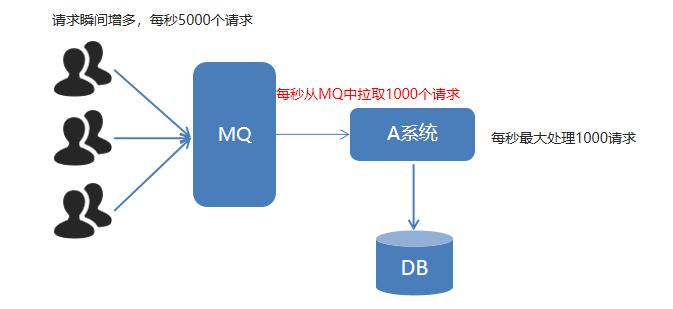
代码
配置文件
<rabbit:listener-container connection-factory="connectionFactory" acknowledge="manual" prefetch="1" >
<rabbit:listener ref="qosListener" queue-names="test_queue_confirm"></rabbit:listener>
</rabbit:listener-container>
|
生产者
@Test
public void testSend() {
for (int i = 0; i < 10; i++) {
rabbitTemplate.convertAndSend("test_exchange_confirm", "confirm", "message confirm....");
}
}
|
消费端
import com.rabbitmq.client.Channel;
import org.springframework.amqp.core.Message;
import org.springframework.amqp.rabbit.listener.api.ChannelAwareMessageListener;
import org.springframework.stereotype.Component;
@Component
public class QosListener implements ChannelAwareMessageListener {
@Override
public void onMessage(Message message, Channel channel) throws Exception {
Thread.sleep(1000);
System.out.println(new String(message.getBody()));
channel.basicAck(message.getMessageProperties().getDeliveryTag(),true);
}
}
|
小结
7.5.TTL
概述
TTL 全称 Time To Live(存活时间/过期时间)。
为消息设置存活时间,当消息到达存活时间后,还没有被消费,会被自动清除。
RabbitMQ可以对消息设置过期时间,也可以对整个队列(Queue)设置过期时间。
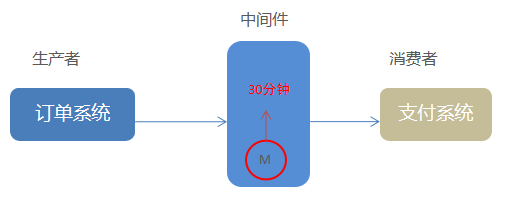
代码
新增队列
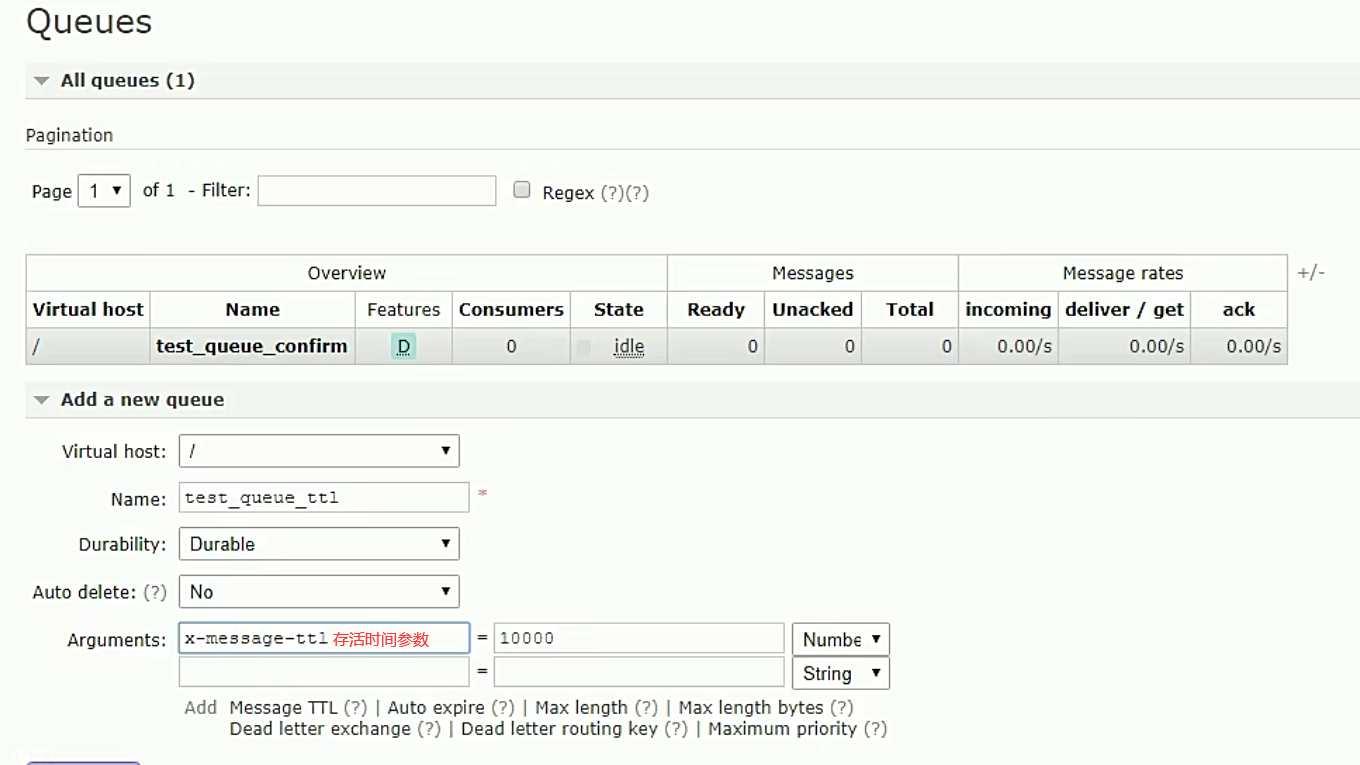
新增交换机
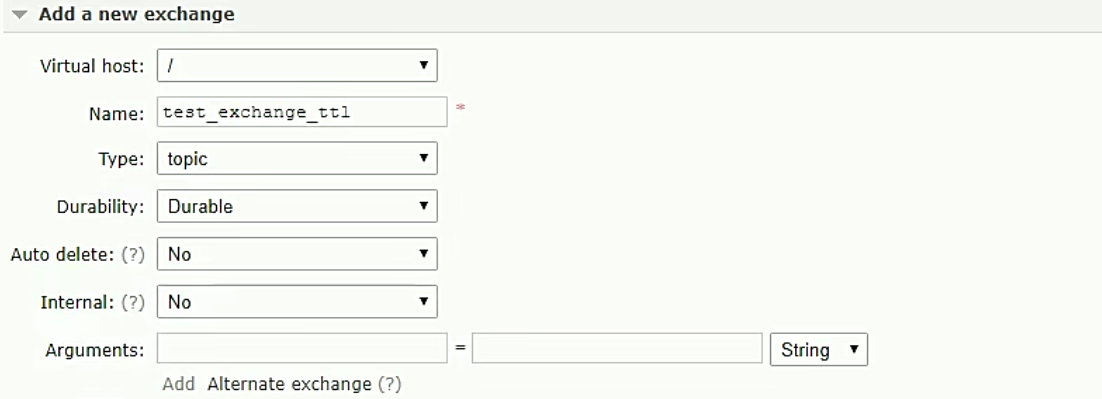
交换机绑定队列
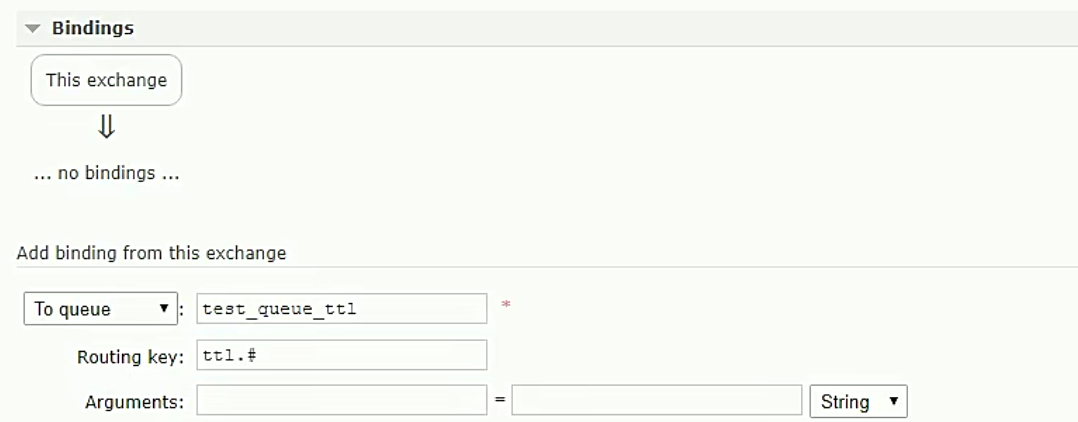
发送消息
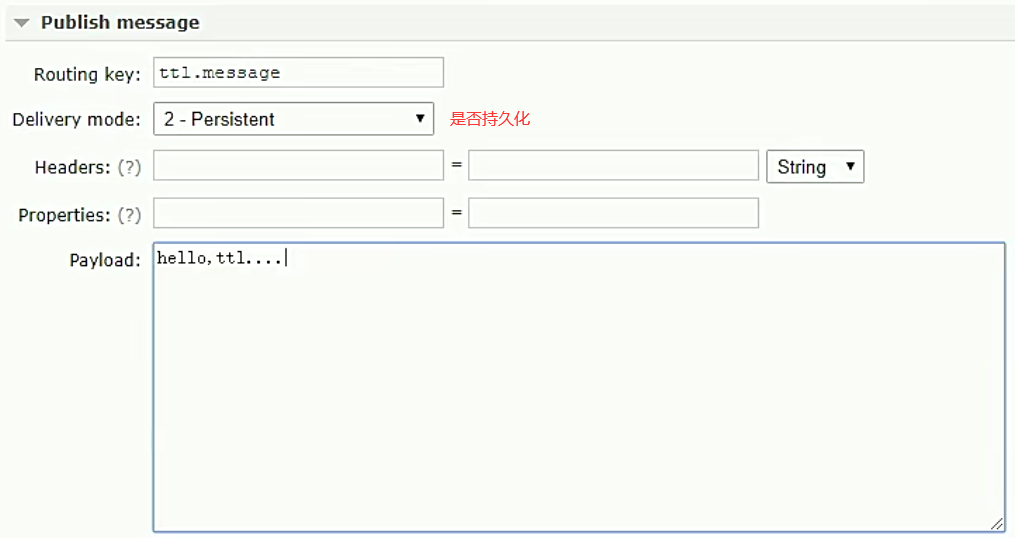
配置文件——生产者
<rabbit:queue name="test_queue_ttl" id="test_queue_ttl">
<rabbit:queue-arguments>
<entry key="x-message-ttl" value="100000" value-type="java.lang.Integer"></entry>
</rabbit:queue-arguments>
</rabbit:queue>
<rabbit:topic-exchange name="test_exchange_ttl" >
<rabbit:bindings>
<rabbit:binding pattern="ttl.#" queue="test_queue_ttl"></rabbit:binding>
</rabbit:bindings>
</rabbit:topic-exchange>
|
生产者
@Test
public void testTtl() {
MessagePostProcessor messagePostProcessor = new MessagePostProcessor() {
@Override
public Message postProcessMessage(Message message) throws AmqpException {
message.getMessageProperties().setExpiration("5000");
return message;
}
};
for (int i = 0; i < 10; i++) {
if(i == 5){
rabbitTemplate.convertAndSend("test_exchange_ttl", "ttl.hehe", "message ttl....",messagePostProcessor);
}else{
rabbitTemplate.convertAndSend("test_exchange_ttl", "ttl.hehe", "message ttl....");
}
}
}
|
消费者
小结
7.6.死信队列
概述
死信队列,英文缩写:DLX 。Dead Letter Exchange(死信交换机),当消息成为Dead message后,可以被重新发送到另一个交换机,这个交换机就是DLX。
生产者生产一条消息,交给交换机,交换机通过路由将消息传递给队列,消费者通过队列消费消息。这是一个正常的流程,而有一些消息在过期时间内没有被消费(或超出队列长度限制的消息,或者被拒绝签收且没有重新放回原目标队列的消息),就可以通过DLX重新发送给另外一个队列,等待被消费。

消息成为死信的三种情况:
- 队列消息长度到达限制(一个队列的容量为10,结果塞了11个进来,>10的消息就会成为死信);
- 消费者拒接消费消息,basicNack/basicReject,并且不把消息重新放入原目标队列,requeue=false;
- 原队列存在消息过期设置,消息到达超时时间未被消费;
队列绑定死信交换机:
- 给队列设置参数:
- x-dead-letter-exchange(设置死信交换机名称)
- x-dead-letter-routing-key(发送消息时指定的routingkey)

代码
配置文件——生产者
<rabbit:queue name="test_queue_dlx" id="test_queue_dlx">
<rabbit:queue-arguments>
<entry key="x-dead-letter-exchange" value="exchange_dlx" />
<entry key="x-dead-letter-routing-key" value="dlx.hehe" />
<entry key="x-message-ttl" value="10000" value-type="java.lang.Integer" />
<entry key="x-max-length" value="10" value-type="java.lang.Integer" />
</rabbit:queue-arguments>
</rabbit:queue>
<rabbit:topic-exchange name="test_exchange_dlx">
<rabbit:bindings>
<rabbit:binding pattern="test.dlx.#" queue="test_queue_dlx"></rabbit:binding>
</rabbit:bindings>
</rabbit:topic-exchange>
<rabbit:queue name="queue_dlx" id="queue_dlx"></rabbit:queue>
<rabbit:topic-exchange name="exchange_dlx">
<rabbit:bindings>
<rabbit:binding pattern="dlx.#" queue="queue_dlx"></rabbit:binding>
</rabbit:bindings>
</rabbit:topic-exchange>
|
生产者
@Test
public void testDlx(){
rabbitTemplate.convertAndSend("test_exchange_dlx","test.dlx.haha","我是一条消息,我会死吗?");
}
|
配置文件——消费者
<rabbit:listener ref="dlxListener" queue-names="test_queue_dlx"></rabbit:listener>
|
消费者
import com.rabbitmq.client.Channel;
import org.springframework.amqp.core.Message;
import org.springframework.amqp.rabbit.listener.api.ChannelAwareMessageListener;
import org.springframework.stereotype.Component;
@Component
public class DlxListener implements ChannelAwareMessageListener {
@Override
public void onMessage(Message message, Channel channel) throws Exception {
long deliveryTag = message.getMessageProperties().getDeliveryTag();
try {
System.out.println(new String(message.getBody()));
System.out.println("处理业务逻辑...");
int i = 3/0;
channel.basicAck(deliveryTag,true);
} catch (Exception e) {
System.out.println("出现异常,拒绝接受");
channel.basicNack(deliveryTag,true,false);
}
}
}
|
小结
- 死信交换机和死信队列和普通的没有区别
- 当消息成为死信后,如果该队列绑定了死信交换机,则消息会被死信交换机重新路由到死信队列
- 消息成为死信的三种情况:
- 队列消息长度到达限制;
- 消费者拒接消费消息,并且不重回队列;
- 原队列存在消息过期设置,消息到达超时时间未被消费;
7.7.延迟队列
概述
延迟队列,即消息进入队列后不会立即被消费,只有到达指定时间后,才会被消费。
需求:
下单后,30分钟未支付,取消订单,回滚库存。
新用户注册成功7天后,发送短信问候。
实现方式:
- 定时器(有误差)
- 延迟队列

很可惜,在RabbitMQ中并未提供延迟队列功能。
但是可以使用:TTL+死信队列 组合实现延迟队列的效果。

定义一个死信交换机和死信队列,再定义一个正常交换机和正常队列,再给正常队列定义一个TTL(过期时间)
代码
配置文件——生产者
<rabbit:queue id="order_queue" name="order_queue">
<rabbit:queue-arguments>
<entry key="x-dead-letter-exchange" value="order_exchange_dlx" />
<entry key="x-dead-letter-routing-key" value="dlx.order.cancel" />
<entry key="x-message-ttl" value="10000" value-type="java.lang.Integer" />
</rabbit:queue-arguments>
</rabbit:queue>
<rabbit:topic-exchange name="order_exchange">
<rabbit:bindings>
<rabbit:binding pattern="order.#" queue="order_queue"></rabbit:binding>
</rabbit:bindings>
</rabbit:topic-exchange>
<rabbit:queue id="order_queue_dlx" name="order_queue_dlx"></rabbit:queue>
<rabbit:topic-exchange name="order_exchange_dlx">
<rabbit:bindings>
<rabbit:binding pattern="dlx.order.#" queue="order_queue_dlx"></rabbit:binding>
</rabbit:bindings>
</rabbit:topic-exchange>
</beans>
|
配置文件——消费者
<rabbit:listener ref="orderListener" queue-names="order_queue_dlx"></rabbit:listener>
</rabbit:listener-container>
|
生产者——发送订单
@Test
public void testDelay() throws InterruptedException {
rabbitTemplate.convertAndSend("order_exchange","order.msg","订单信息:id=1,time=2019年8月17日16:41:47");
}
|
消费者——OrderListener
import com.rabbitmq.client.Channel;
import org.springframework.amqp.core.Message;
import org.springframework.amqp.rabbit.listener.api.ChannelAwareMessageListener;
import org.springframework.stereotype.Component;
@Component
public class OrderListener implements ChannelAwareMessageListener {
@Override
public void onMessage(Message message, Channel channel) throws Exception {
long deliveryTag = message.getMessageProperties().getDeliveryTag();
try {
System.out.println(new String(message.getBody()));
System.out.println("处理业务逻辑...");
System.out.println("根据订单id查询其状态...");
System.out.println("判断状态是否为支付成功");
System.out.println("取消订单,回滚库存....");
channel.basicAck(deliveryTag,true);
} catch (Exception e) {
System.out.println("出现异常,拒绝接受");
channel.basicNack(deliveryTag,true,false);
}
}
}
|
小结
- 延迟队列 指消息进入队列后,可以被延迟一定时间,再进行消费。
- RabbitMQ没有提供延迟队列功能,但是可以使用 : TTL + DLX 来实现延迟队列效果。
7.8.日志与监控
日志
RabbitMQ默认日志存放路径: /var/log/rabbitmq/rabbit@xxx.log
日志包含了RabbitMQ的版本号、Erlang的版本号、RabbitMQ服务节点名称、cookie的hash值、RabbitMQ配置文件地址、内存限制、磁盘限制、默认账户guest的创建以及权限配置等等。
监控
web管控台监控
ip:5672
7.9.消息可靠性分析与追踪
消息追踪——概述
在使用任何消息中间件的过程中,难免会出现某条消息异常丢失的情况。对于RabbitMQ而言,可能是因为生产者或消费者与RabbitMQ断开了连接,而它们与abbitMQ又采用了不同的确认机制;也有可能是因为交换器与队列之间不同的转发策略;甚至是交换器并没有与任何队列进行绑定,生产者又不感知或者没有采取相应的措施;另外RabbitMQ本身的集群策略也可能导致消息的丢失。这个时候就需要有一个较好的机制跟踪记录消息的投递过程,以此协助开发和运维人员进行问题的定位。
在RabbitMQ中可以使用Firehose和rabbitmq_tracing插件功能来实现消息追踪。
Firehose
firehose的机制是将生产者投递给rabbitmq的消息,rabbitmq投递给消费者的消息按照指定的格式发送到默认的exchange上。这个默认的exchange的名称为amq.rabbitmq.trace,它是一个topic类型的exchange。发送到这个exchange上的消息的routing key为 publish.exchangename 和 deliver.queuename。其中exchangename和queuename为实际exchange和queue的名称,分别对应生产者投递到exchange的消息,和消费者从queue上获取的消息。
注意:打开 trace 会影响消息写入功能,适当打开后请关闭。
- rabbitmqctl trace_on:开启Firehose命令
- rabbitmqctl trace_off:关闭Firehose命令
rabbitmq_tracing
rabbitmq_tracing和Firehose在实现上如出一辙,只不过rabbitmq_tracing的方式比Firehose多了一层GUI的包装,更容易使用和管理。
启用插件:rabbitmq-plugins enable rabbitmq_tracing
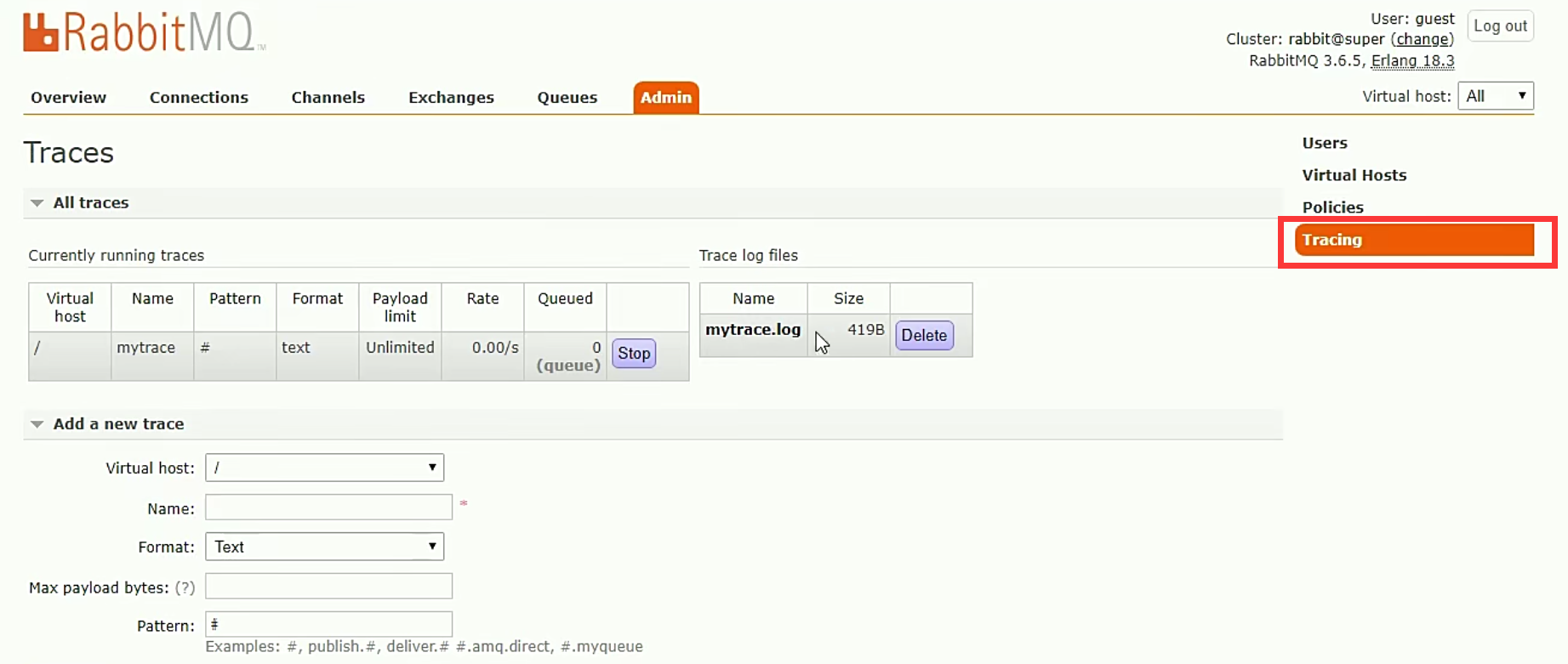
7.10.管理
rabbitmqctl管理和监控
查看队列
# rabbitmqctl list_queues
查看exchanges
# rabbitmqctl list_exchanges
查看用户
# rabbitmqctl list_users
查看连接
# rabbitmqctl list_connections
查看消费者信息
# rabbitmqctl list_consumers
查看环境变量
# rabbitmqctl environment
查看未被确认的队列
# rabbitmqctl list_queues name messages_unacknowledged
查看单个队列的内存使用
# rabbitmqctl list_queues name memory
查看准备就绪的队列
# rabbitmqctl list_queues name messages_ready
|
8.RabbitMQ应用问题
8.1.消息可靠性保障
需求:100%确保消息发送成功
消息补偿机制
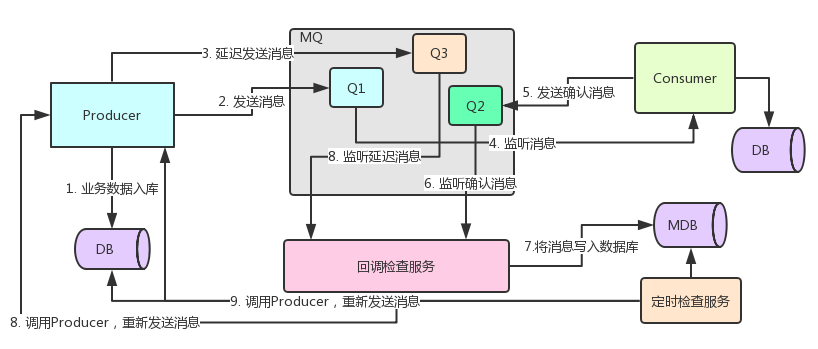
流程
Producer首先需要将业务数据入库DB
然后向交换机发送消息、交换机收到消息后通过路由交给对应的队列Q1
Consumer从对应的队列中获取消息拿去消费,消费后也将业务数据入库DB
问题:当1中的入库成功,但2操作失败,Consumer就无法获取到数据,也会失败。
解决方法:在2操作结束后,延时发送相同的消息给交换机,并交给对应的队列Q3
若Consumer操作成功,会反馈一条确认消息给交换机,并交给对应的队列Q2
此时,回调检查服务一直在监听Q2,一旦监听到确认消息,便将消息写入到数据库(MDB)
同时回调检查消息也一直在监听Q3,并将收到的消息和Q1、Q2(刚刚存到MDB中的数据)中id进行比对,若id一致,说明该条消息已经被消费过了。
若没有该id,说明发送失败了,这时回调检查服务向Producer发送请求,让Producer重新发送消息。
还存在一问题:若发送消息和延时发送消息都失败了,该如何解决?
解决方法:通过定时检查服务,对比MDB和DB中的数据是否一致
若不一致,这时定时检查服务向Producer发送请求,让Producer重新发送没有发送过的消息。
8.2.消息幂等性处理
幂等性指一次和多次请求某一个资源,对于资源本身应该具有同样的结果。也就是说,其任意多次执行对资源本身所产生的影响均与一次执行的影响相同。
在MQ中指,消费多条相同的消息,得到与消费该消息一次相同的结果。
乐观锁机制
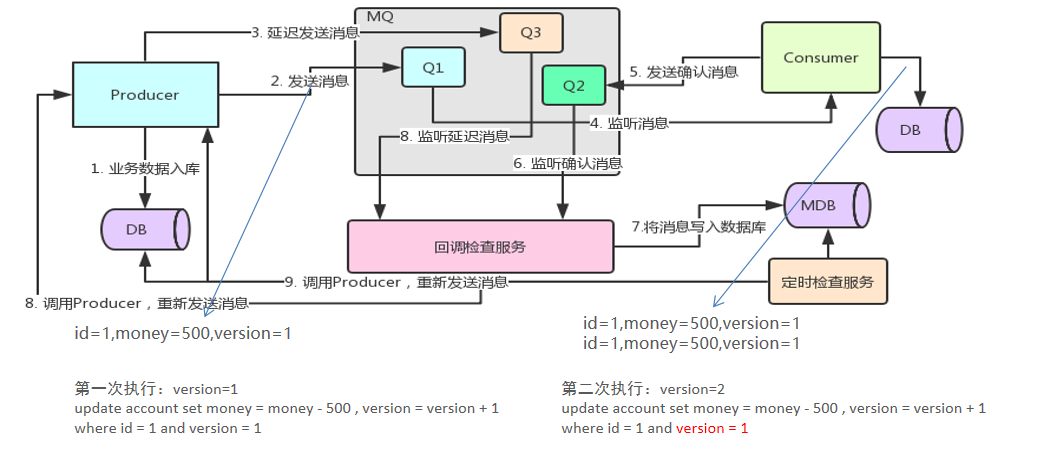
流程
- 在发送消息的时候,设置一个版本号,每一次发送时版本号+1
- 在比对或者判断时候,会根据不同的版本号区分不同的发送的消息
- 相同的消息只会被确认一次
9.RabbitMQ集群搭建
摘要:实际生产应用中都会采用消息队列的集群方案,如果选择RabbitMQ那么有必要了解下它的集群方案原理
一般来说,如果只是为了学习RabbitMQ或者验证业务工程的正确性那么在本地环境或者测试环境上使用其单实例部署就可以了,但是出于MQ中间件本身的可靠性、并发性、吞吐量和消息堆积能力等问题的考虑,在生产环境上一般都会考虑使用RabbitMQ的集群方案。
9.1 集群方案的原理
RabbitMQ这款消息队列中间件产品本身是基于Erlang编写,Erlang语言天生具备分布式特性(通过同步Erlang集群各节点的magic cookie来实现)。因此,RabbitMQ天然支持Clustering。这使得RabbitMQ本身不需要像ActiveMQ、Kafka那样通过ZooKeeper分别来实现HA方案和保存集群的元数据。集群是保证可靠性的一种方式,同时可以通过水平扩展以达到增加消息吞吐量能力的目的。
HAProxy帮助代理RabbitMQ集群,向Producer和Consumer提供统一的接口,同时每一个RabbitMQ之间通过镜像队列的方式相互连接。

9.2 单机多实例部署
由于某些因素的限制,有时候你不得不在一台机器上去搭建一个rabbitmq集群,这个有点类似zookeeper的单机版。真实生成环境还是要配成多机集群的。有关怎么配置多机集群的可以参考其他的资料,这里主要论述如何在单机中配置多个rabbitmq实例。
主要参考官方文档:https://www.rabbitmq.com/clustering.html
首先确保RabbitMQ运行没有问题
[root@super ~]# rabbitmqctl status
Status of node rabbit@super ...
[{pid,10232},
{running_applications,
[{rabbitmq_management,"RabbitMQ Management Console","3.6.5"},
{rabbitmq_web_dispatch,"RabbitMQ Web Dispatcher","3.6.5"},
{webmachine,"webmachine","1.10.3"},
{mochiweb,"MochiMedia Web Server","2.13.1"},
{rabbitmq_management_agent,"RabbitMQ Management Agent","3.6.5"},
{rabbit,"RabbitMQ","3.6.5"},
{os_mon,"CPO CXC 138 46","2.4"},
{syntax_tools,"Syntax tools","1.7"},
{inets,"INETS CXC 138 49","6.2"},
{amqp_client,"RabbitMQ AMQP Client","3.6.5"},
{rabbit_common,[],"3.6.5"},
{ssl,"Erlang/OTP SSL application","7.3"},
{public_key,"Public key infrastructure","1.1.1"},
{asn1,"The Erlang ASN1 compiler version 4.0.2","4.0.2"},
{ranch,"Socket acceptor pool for TCP protocols.","1.2.1"},
{mnesia,"MNESIA CXC 138 12","4.13.3"},
{compiler,"ERTS CXC 138 10","6.0.3"},
{crypto,"CRYPTO","3.6.3"},
{xmerl,"XML parser","1.3.10"},
{sasl,"SASL CXC 138 11","2.7"},
{stdlib,"ERTS CXC 138 10","2.8"},
{kernel,"ERTS CXC 138 10","4.2"}]},
{os,{unix,linux}},
{erlang_version,
"Erlang/OTP 18 [erts-7.3] [source] [64-bit] [async-threads:64] [hipe] [kernel-poll:true]\n"},
{memory,
[{total,56066752},
{connection_readers,0},
{connection_writers,0},
{connection_channels,0},
{connection_other,2680},
{queue_procs,268248},
{queue_slave_procs,0},
{plugins,1131936},
{other_proc,18144280},
{mnesia,125304},
{mgmt_db,921312},
{msg_index,69440},
{other_ets,1413664},
{binary,755736},
{code,27824046},
{atom,1000601},
{other_system,4409505}]},
{alarms,[]},
{listeners,[{clustering,25672,"::"},{amqp,5672,"::"}]},
{vm_memory_high_watermark,0.4},
{vm_memory_limit,411294105},
{disk_free_limit,50000000},
{disk_free,13270233088},
{file_descriptors,
[{total_limit,924},{total_used,6},{sockets_limit,829},{sockets_used,0}]},
{processes,[{limit,1048576},{used,262}]},
{run_queue,0},
{uptime,43651},
{kernel,{net_ticktime,60}}]
|
停止rabbitmq服务
[root@super sbin]# service rabbitmq-server stop
Stopping rabbitmq-server: rabbitmq-server.
|
启动第一个节点:
[root@super sbin]# RABBITMQ_NODE_PORT=5673 RABBITMQ_NODENAME=rabbit1 rabbitmq-server start
RabbitMQ 3.6.5. Copyright (C) 2007-2016 Pivotal Software, Inc.
#
#
#
#
#
Starting broker...
completed with 6 plugins.
|
启动第二个节点:
web管理插件端口占用,所以还要指定其web插件占用的端口号。
[root@super ~]# RABBITMQ_NODE_PORT=5674 RABBITMQ_SERVER_START_ARGS="-rabbitmq_management listener [{port,15674}]" RABBITMQ_NODENAME=rabbit2 rabbitmq-server start
RabbitMQ 3.6.5. Copyright (C) 2007-2016 Pivotal Software, Inc.
#
#
#
#
#
Starting broker...
completed with 6 plugins.
|
结束命令:
rabbitmqctl -n rabbit1 stop
rabbitmqctl -n rabbit2 stop
|
rabbit1操作作为主节点:
[root@super ~]# rabbitmqctl -n rabbit1 stop_app
Stopping node rabbit1@super ...
[root@super ~]# rabbitmqctl -n rabbit1 reset
Resetting node rabbit1@super ...
[root@super ~]# rabbitmqctl -n rabbit1 start_app
Starting node rabbit1@super ...
[root@super ~]#
|
rabbit2操作为从节点:
[root@super ~]# rabbitmqctl -n rabbit2 stop_app
Stopping node rabbit2@super ...
[root@super ~]# rabbitmqctl -n rabbit2 reset
Resetting node rabbit2@super ...
[root@super ~]# rabbitmqctl -n rabbit2 join_cluster rabbit1@'super' #'super'内是主机名换成自己的
Clustering node rabbit2@super with rabbit1@super ...
[root@super ~]# rabbitmqctl -n rabbit2 start_app
Starting node rabbit2@super ...
|
查看集群状态:
[root@super ~]# rabbitmqctl cluster_status -n rabbit1
Cluster status of node rabbit1@super ...
[{nodes,[{disc,[rabbit1@super,rabbit2@super]}]},
{running_nodes,[rabbit2@super,rabbit1@super]},
{cluster_name,<<"rabbit1@super">>},
{partitions,[]},
{alarms,[{rabbit2@super,[]},{rabbit1@super,[]}]}]
|
web监控:

9.3 集群管理
rabbitmqctl join_cluster {cluster_node} [–ram]
将节点加入指定集群中。在这个命令执行前需要停止RabbitMQ应用并重置节点。
rabbitmqctl cluster_status
显示集群的状态。
rabbitmqctl change_cluster_node_type {disc|ram}
修改集群节点的类型。在这个命令执行前需要停止RabbitMQ应用。
rabbitmqctl forget_cluster_node [–offline]
将节点从集群中删除,允许离线执行。
rabbitmqctl update_cluster_nodes {clusternode}
在集群中的节点应用启动前咨询clusternode节点的最新信息,并更新相应的集群信息。这个和join_cluster不同,它不加入集群。考虑这样一种情况,节点A和节点B都在集群中,当节点A离线了,节点C又和节点B组成了一个集群,然后节点B又离开了集群,当A醒来的时候,它会尝试联系节点B,但是这样会失败,因为节点B已经不在集群中了。
rabbitmqctl cancel_sync_queue [-p vhost] {queue}
取消队列queue同步镜像的操作。
rabbitmqctl set_cluster_name {name}
设置集群名称。集群名称在客户端连接时会通报给客户端。Federation和Shovel插件也会有用到集群名称的地方。集群名称默认是集群中第一个节点的名称,通过这个命令可以重新设置。
9.4 RabbitMQ镜像集群配置
上面已经完成RabbitMQ默认集群模式,但并不保证队列的高可用性,尽管交换机、绑定这些可以复制到集群里的任何一个节点,但是队列内容不会复制。虽然该模式解决一项目组节点压力,但队列节点宕机直接导致该队列无法应用,只能等待重启,所以要想在队列节点宕机或故障也能正常应用,就要复制队列内容到集群里的每个节点,必须要创建镜像队列。
镜像队列是基于普通的集群模式的,然后再添加一些策略,所以你还是得先配置普通集群,然后才能设置镜像队列,我们就以上面的集群接着做。
设置的镜像队列可以通过开启的网页的管理端Admin->Policies,也可以通过命令。
rabbitmqctl set_policy my_ha “^” ‘{“ha-mode”:”all”}’
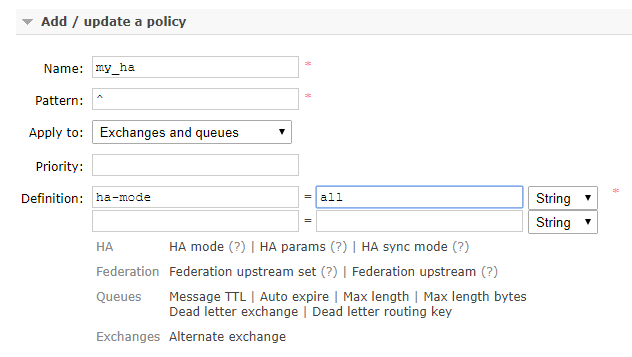
- Name:策略名称
- Pattern:匹配的规则,如果是匹配所有的队列,是^.
- Definition:使用ha-mode模式中的all,也就是同步所有匹配的队列。问号链接帮助文档。
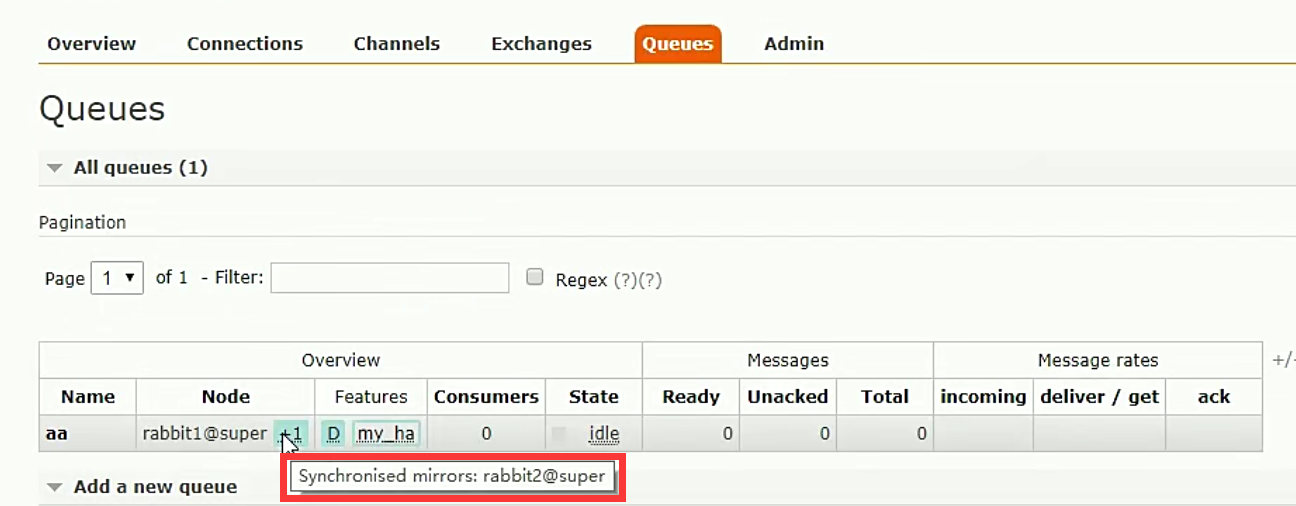
9.5 负载均衡-HAProxy
HAProxy提供高可用性、负载均衡以及基于TCP和HTTP应用的代理,支持虚拟主机,它是免费、快速并且可靠的一种解决方案,包括Twitter,Reddit,StackOverflow,GitHub在内的多家知名互联网公司在使用。HAProxy实现了一种事件驱动、单一进程模型,此模型支持非常大的并发连接数。
9.5.1 安装HAProxy
//下载依赖包
yum install gcc vim wget
//上传haproxy源码包
//解压
tar -zxvf haproxy-1.6.5.tar.gz -C /usr/local
//进入目录、进行编译、安装
cd /usr/local/haproxy-1.6.5
make TARGET=linux31 PREFIX=/usr/local/haproxy
make install PREFIX=/usr/local/haproxy
mkdir /etc/haproxy
//赋权
groupadd -r -g 149 haproxy
useradd -g haproxy -r -s /sbin/nologin -u 149 haproxy
//创建haproxy配置文件
mkdir /etc/haproxy
vim /etc/haproxy/haproxy.cfg
|
9.5.2 配置HAProxy
配置文件路径:/etc/haproxy/haproxy.cfg
#logging options
global
log 127.0.0.1 local0 info
maxconn 5120
chroot /usr/local/haproxy
uid 99
gid 99
daemon
quiet
nbproc 20
pidfile /var/run/haproxy.pid
defaults
log global
mode tcp
option tcplog
option dontlognull
retries 3
option redispatch
maxconn 2000
contimeout 5s
clitimeout 60s
srvtimeout 15s
#front-end IP for consumers and producters
listen rabbitmq_cluster
bind 0.0.0.0:5672
mode tcp
#balance url_param userid
#balance url_param session_id check_post 64
#balance hdr(User-Agent)
#balance hdr(host)
#balance hdr(Host) use_domain_only
#balance rdp-cookie
#balance leastconn
#balance source //ip
balance roundrobin
server node1 127.0.0.1:5673 check inter 5000 rise 2 fall 2#第一个
server node2 127.0.0.1:5674 check inter 5000 rise 2 fall 2#第二个
listen stats
bind 172.16.98.133:8100
mode http
option httplog
stats enable
stats uri /rabbitmq-stats
stats refresh 5s
|
启动HAproxy负载
/usr/local/haproxy/sbin/haproxy -f /etc/haproxy/haproxy.cfg
//查看haproxy进程状态
ps -ef | grep haproxy
访问如下地址对mq节点进行监控
http://172.16.98.133:8100/rabbitmq-stats
|
代码中访问mq集群地址,则变为访问haproxy地址:5672
测试类
import com.rabbitmq.client.Channel;
import com.rabbitmq.client.Connection;
import com.rabbitmq.client.ConnectionFactory;
import java.io.IOException;
import java.util.concurrent.TimeoutException;
public class HelloWorld {
public static void main(String[] args) throws IOException, TimeoutException {
ConnectionFactory factory = new ConnectionFactory();
factory.setHost("172.16.98.133");
factory.setPort(5672);
Connection connection = factory.newConnection();
Channel channel = connection.createChannel();
channel.queueDeclare("hello_world",true,false,false,null);
String body = "hello rabbitmq~~~";
channel.basicPublish("","hello_world",null,body.getBytes());
channel.close();
connection.close();
System.out.println("send success....");
}
}
|


















